Last updated: 20th February 2022
Table of Contents
Joburg
We decided to take a small group touring holiday and booked a 3 week guided tour of South Africa starting in Johannesburg, also known as ‘Joburg’ or ‘Jozi’ for short. We did question ourselves about visiting Johannesburg after reading about the high crime rate and it’s considered to be one of the most dangerous cities in the world. Most international flights to South Africa land here, so we thought we’d give it a go because we would have the safety of a small guided tour to explore the city. Fortunately for us Brits we didn’t have any jet-lag as the time zone is the same as the UK, we were just a bit tired after 2 long flights via Dubai. We both felt a little anxious when we arrived at our hotel, as we never stayed anywhere guarded, fenced in and surrounded by barbed wire!
Mansions Meet Townships
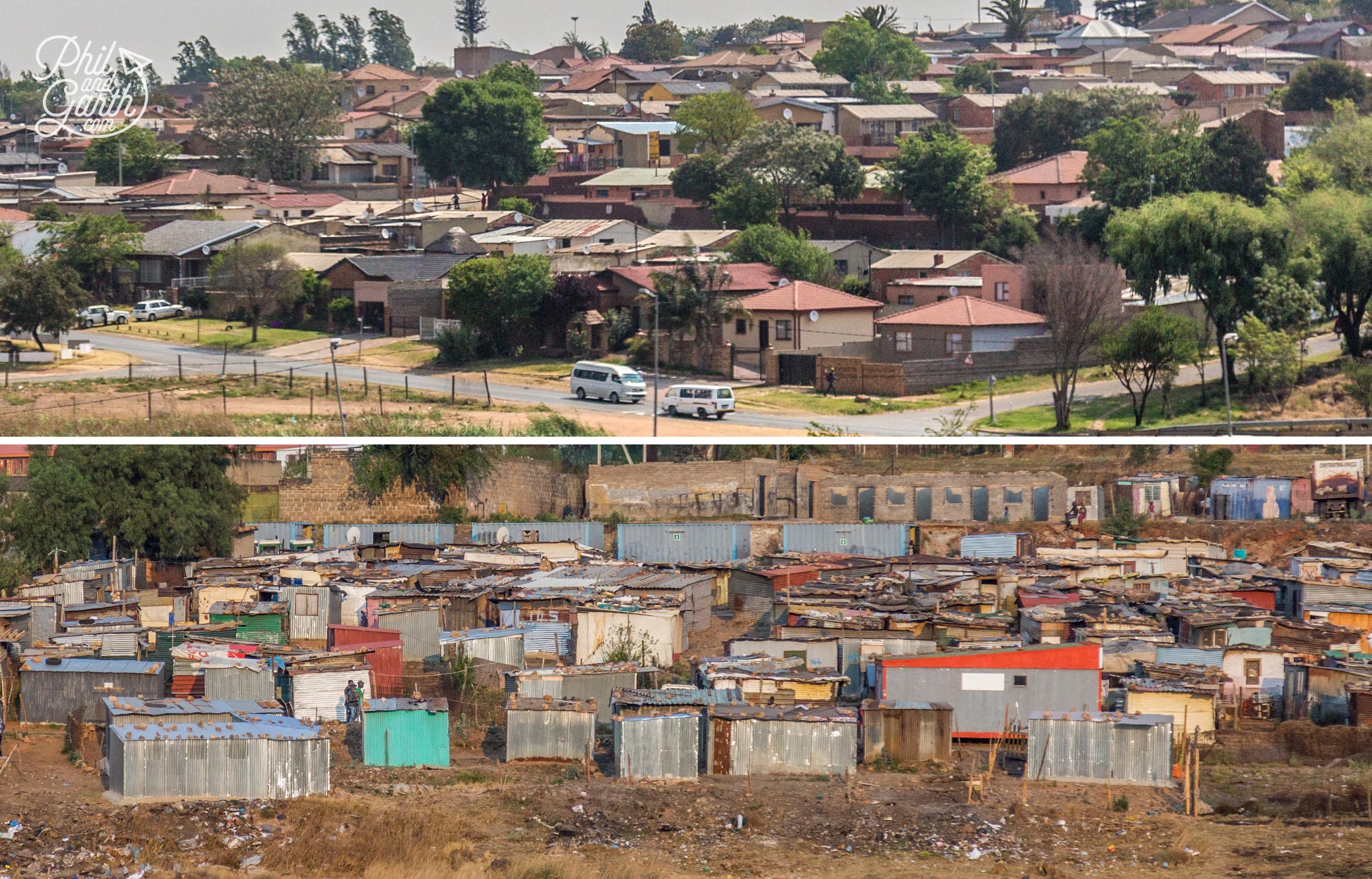
A common sight in Soweto affluent areas sit next to smaller townships
What first struck us about Johannesburg is the divide between rich and poor, it really is shocking. Apartheid ended in 1994, but even after over 20 years there’s still clearly a legacy where people live separately divided by wealth but also side by side. Middle class suburbs sit next to huge shanty towns or ‘townships’ as they are called in South Africa. People live in terrible conditions on top of each other under tiny tin roof homes, we’ve seen poverty before in Asian countries like Cambodia, but this is an another level. This divide is considered to be the main reason behind the high crime rates in Johannesburg.
Johannesburg History as The City of Gold
We stayed for a couple of nights so we only really had one full day in Johannesburg. We started by meeting our local guide who took us by minibus to see the township of Soweto and the various museums located here. Getting there by motorway was fascinating passing old quarries – echos of Joburg’s old gold-rush days. Johannesburg was founded as a gold-mining town in 1886 when it was discovered the area sits on the world’s largest gold reserve, it became the richest city in Africa. Today they still mine for gold and diamond North and West of the city. The only remaining mine in Johannesburg is now part of a theme park and casino called Gold Reef City where tourists can tour the disused mine.
Soweto
Soweto is a city located in the South of Johannesburg and was created in the 1930s when the government began separating black people from white people – apartheid. Today Soweto is made up of 29 townships and is around 40 square miles, it has more than 2 million inhabitants and is where 40% of Johannesburg’s population live. Soweto is also South Africa’s largest township.
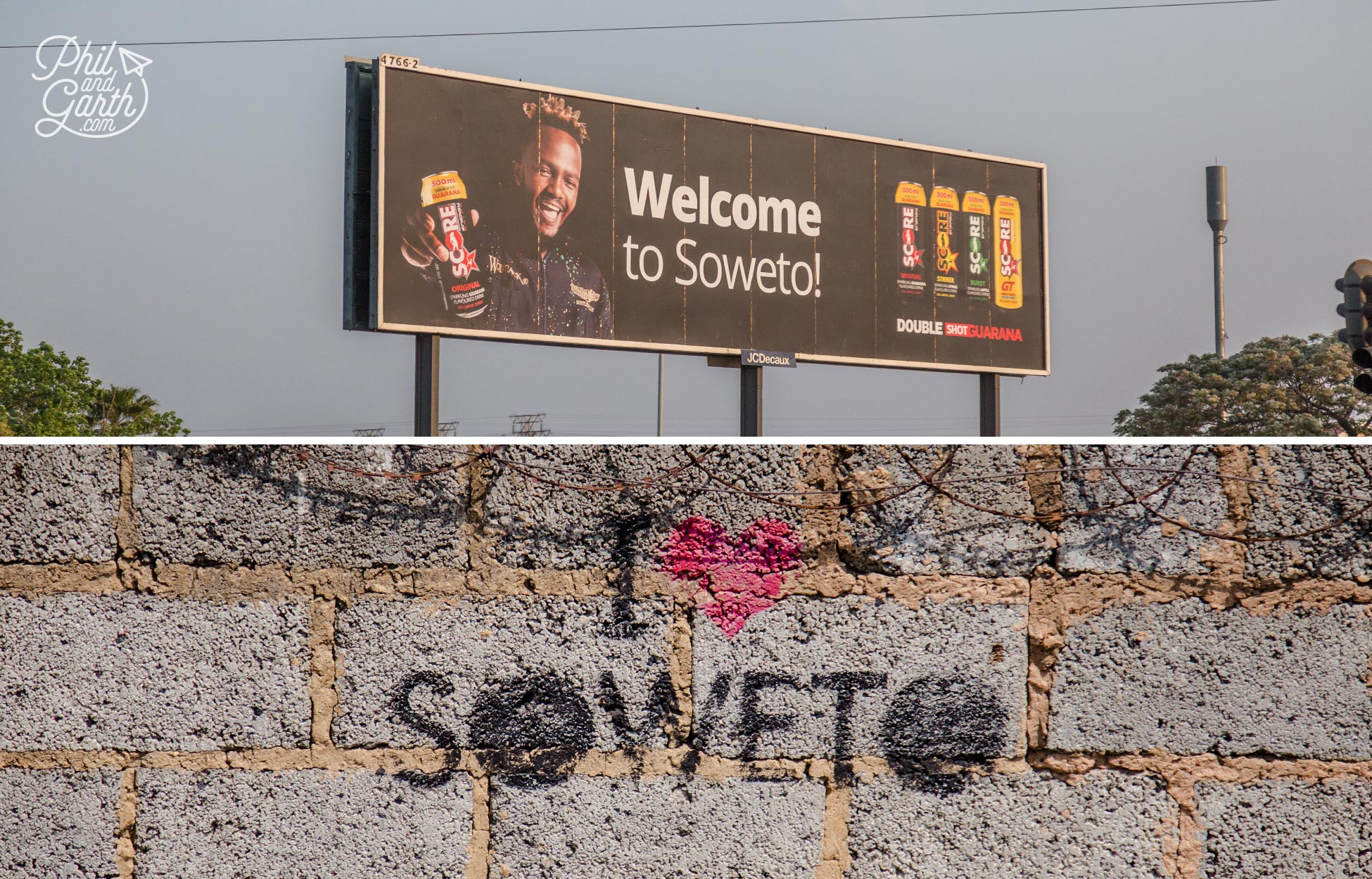
Welcome to Soweto!
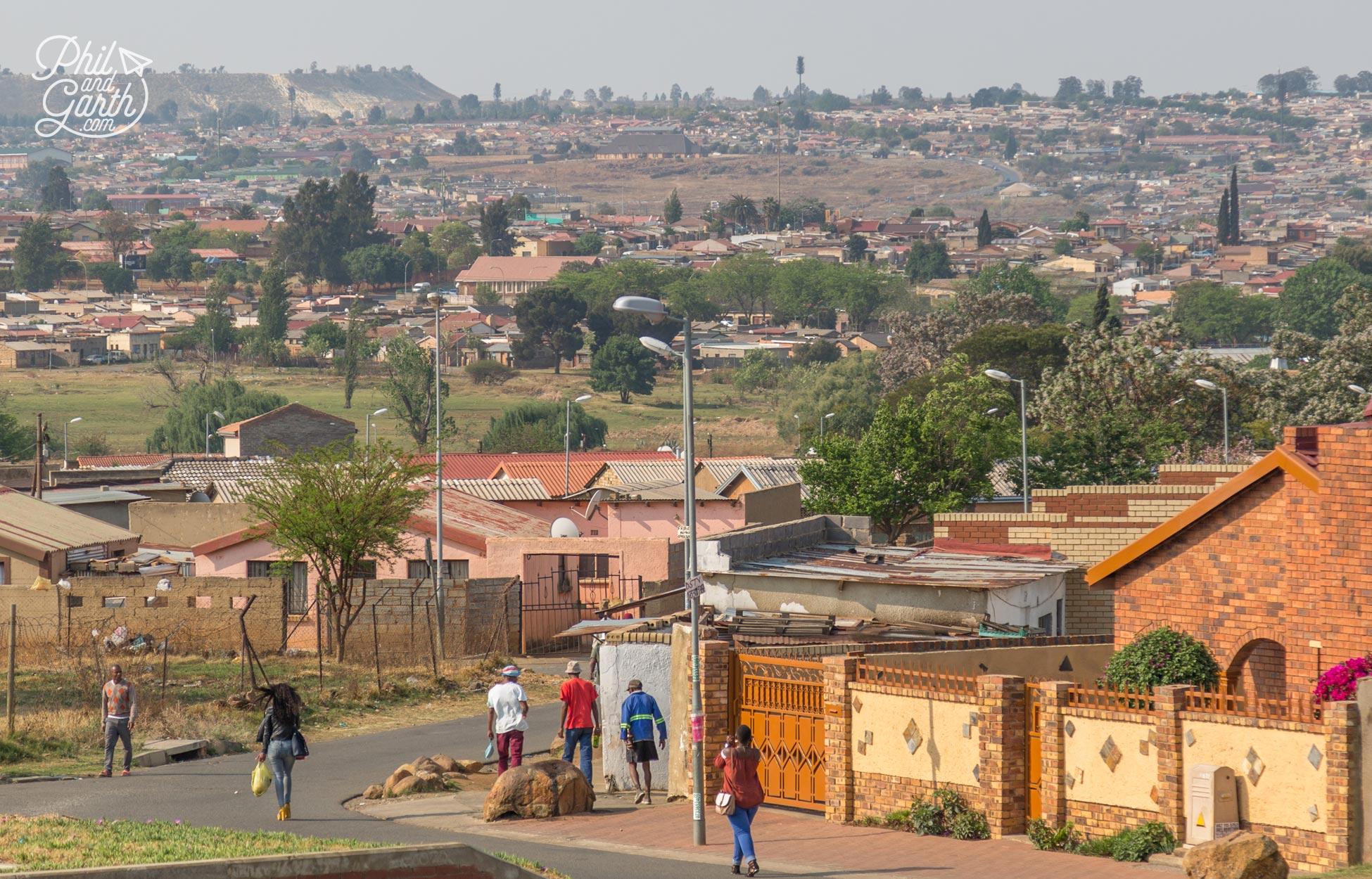
Soweto, Johannesburg
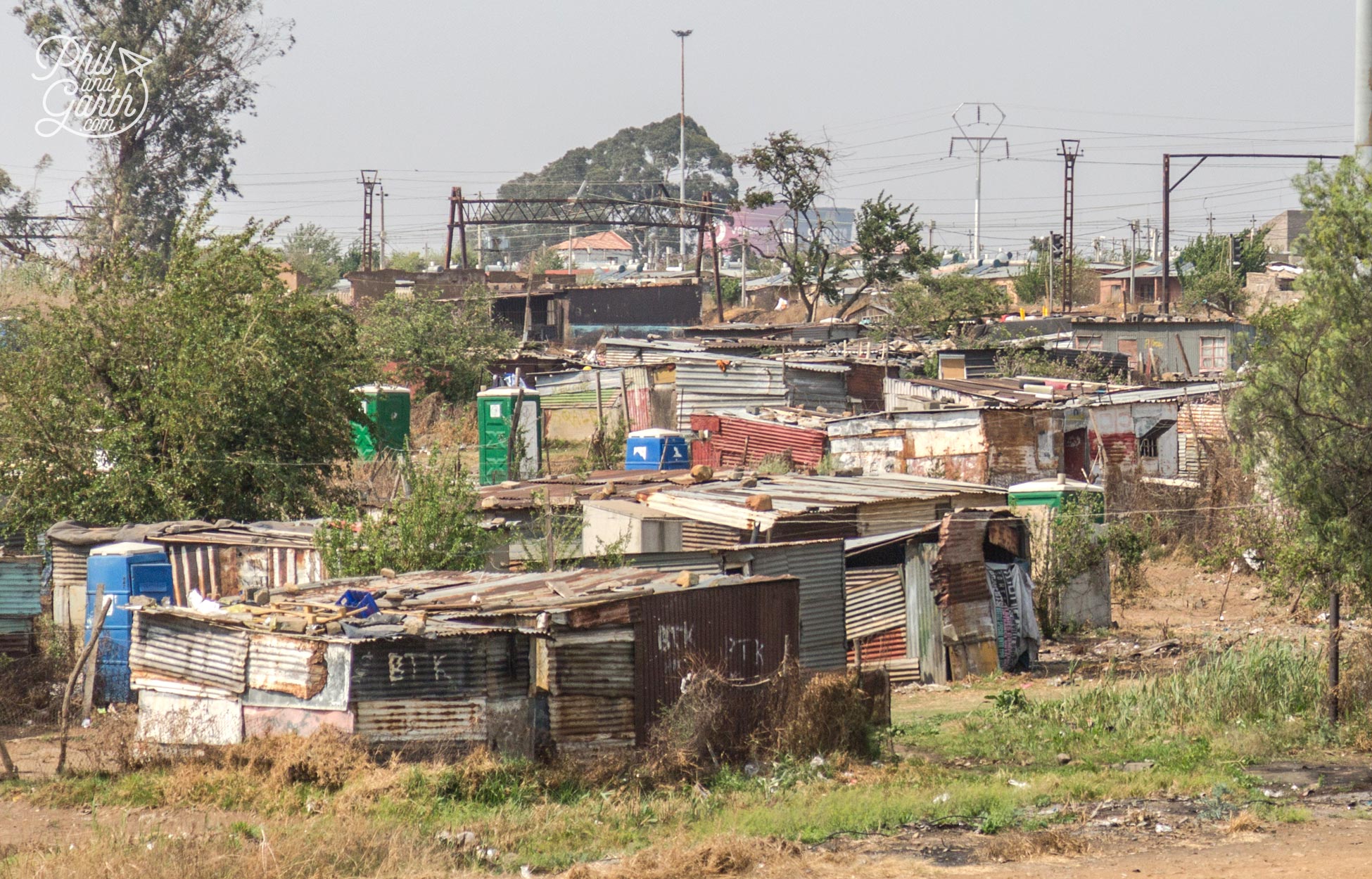
A smaller Soweto township
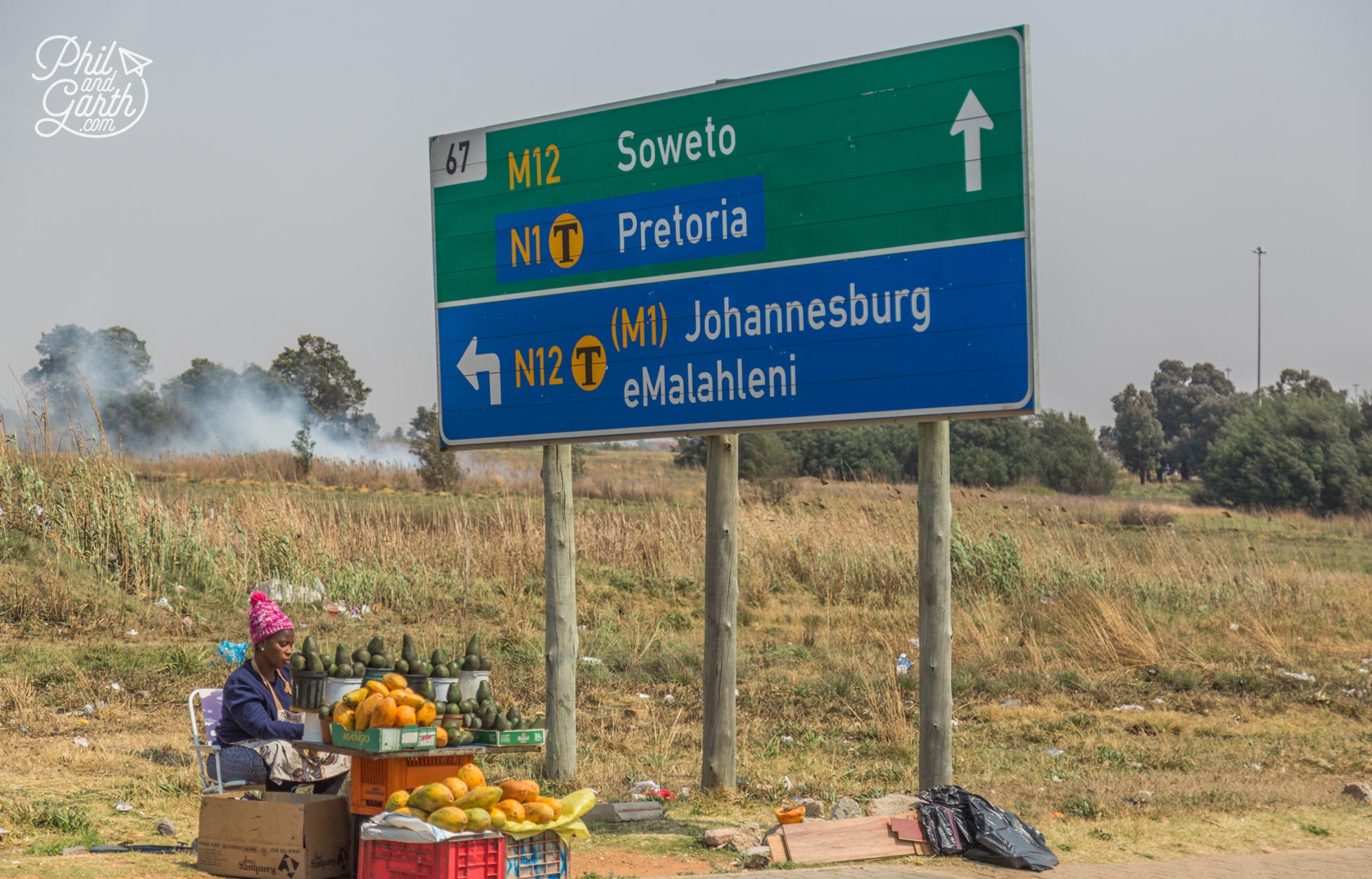
We saw loads of people selling fruit and vegetables on the sides of roads
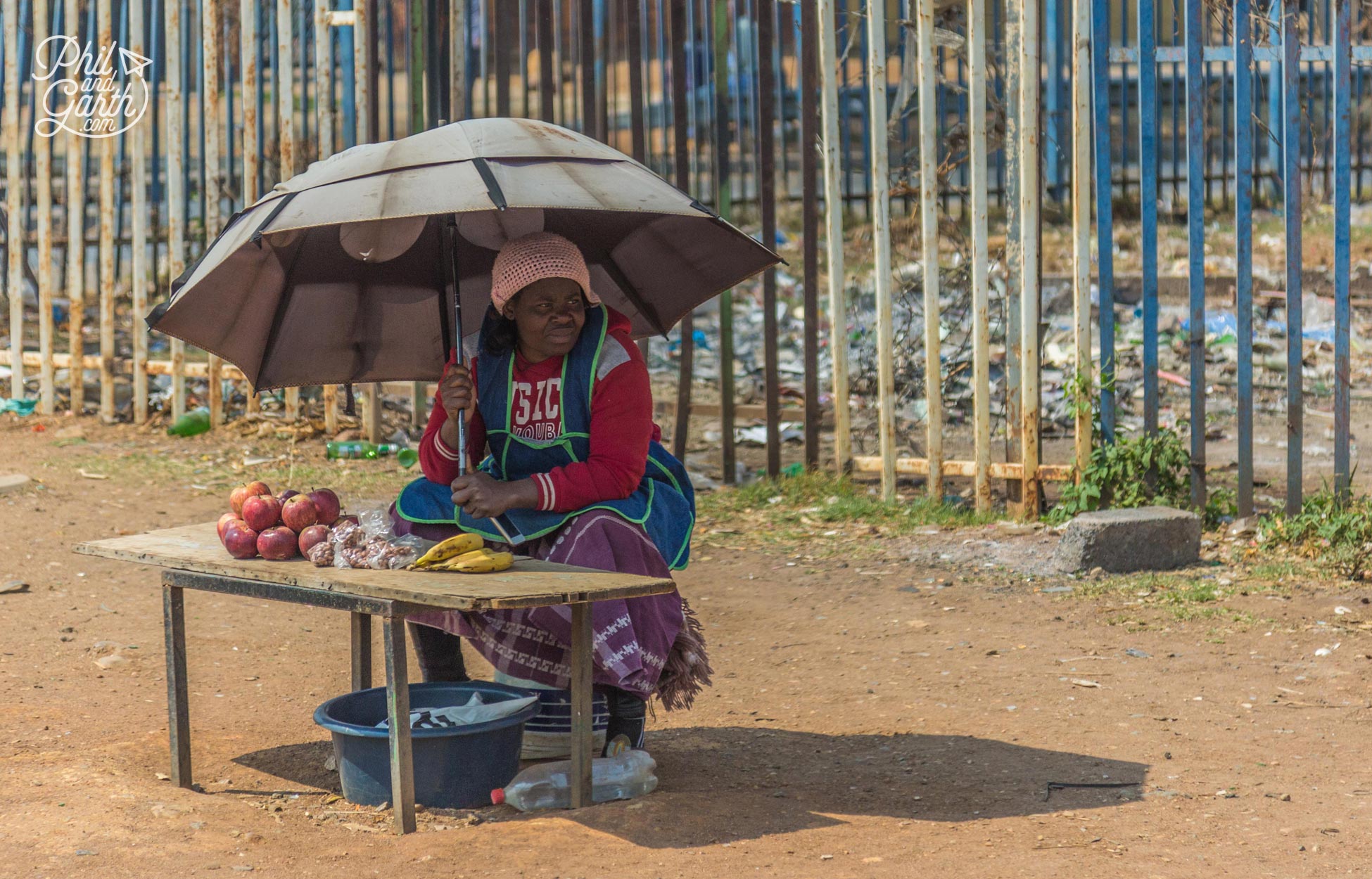
A lady sells a small amount of bananas, apples and nuts
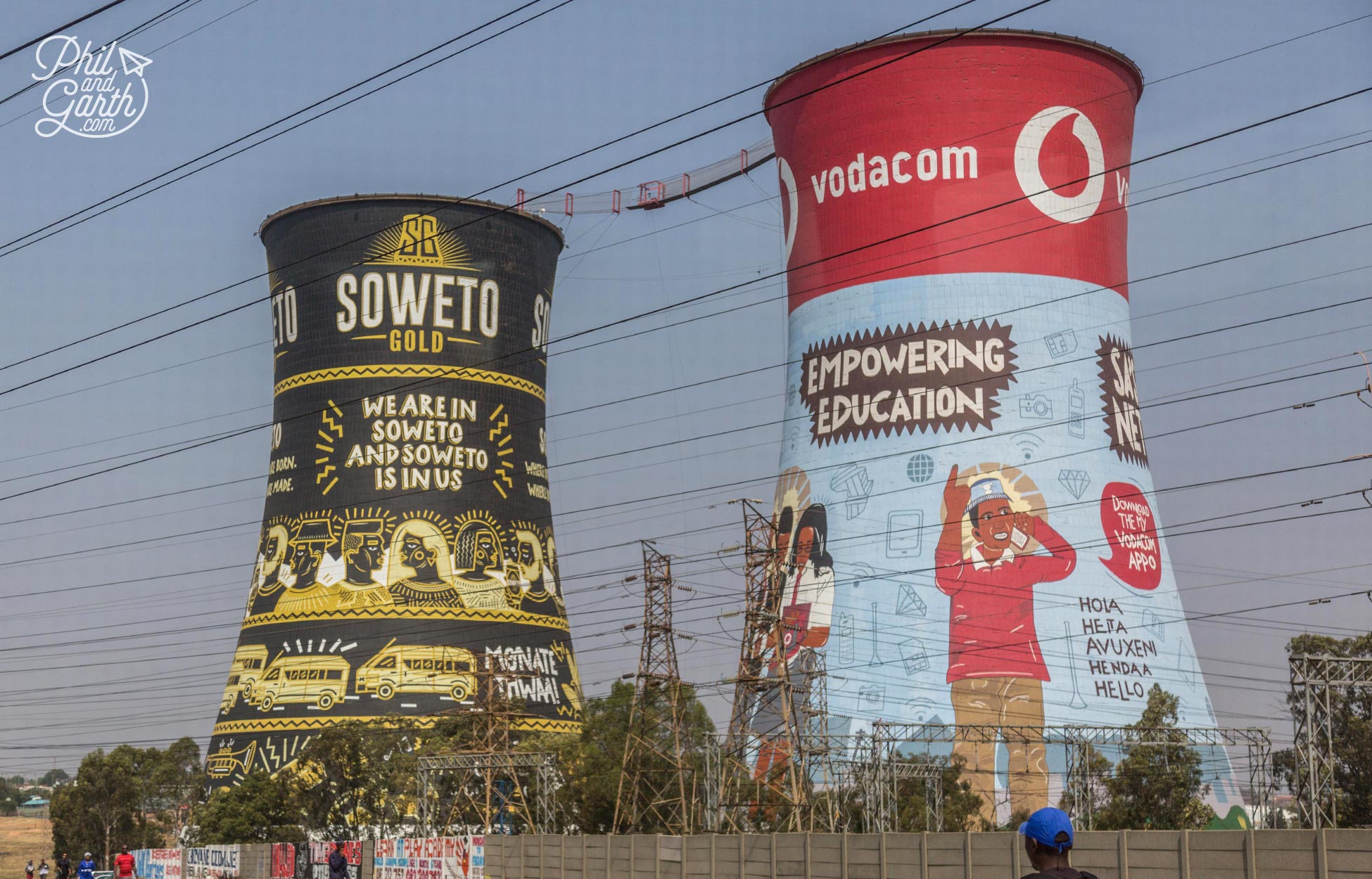
Soweto’s famous Orlando Towers – now a playground for thrill seekers
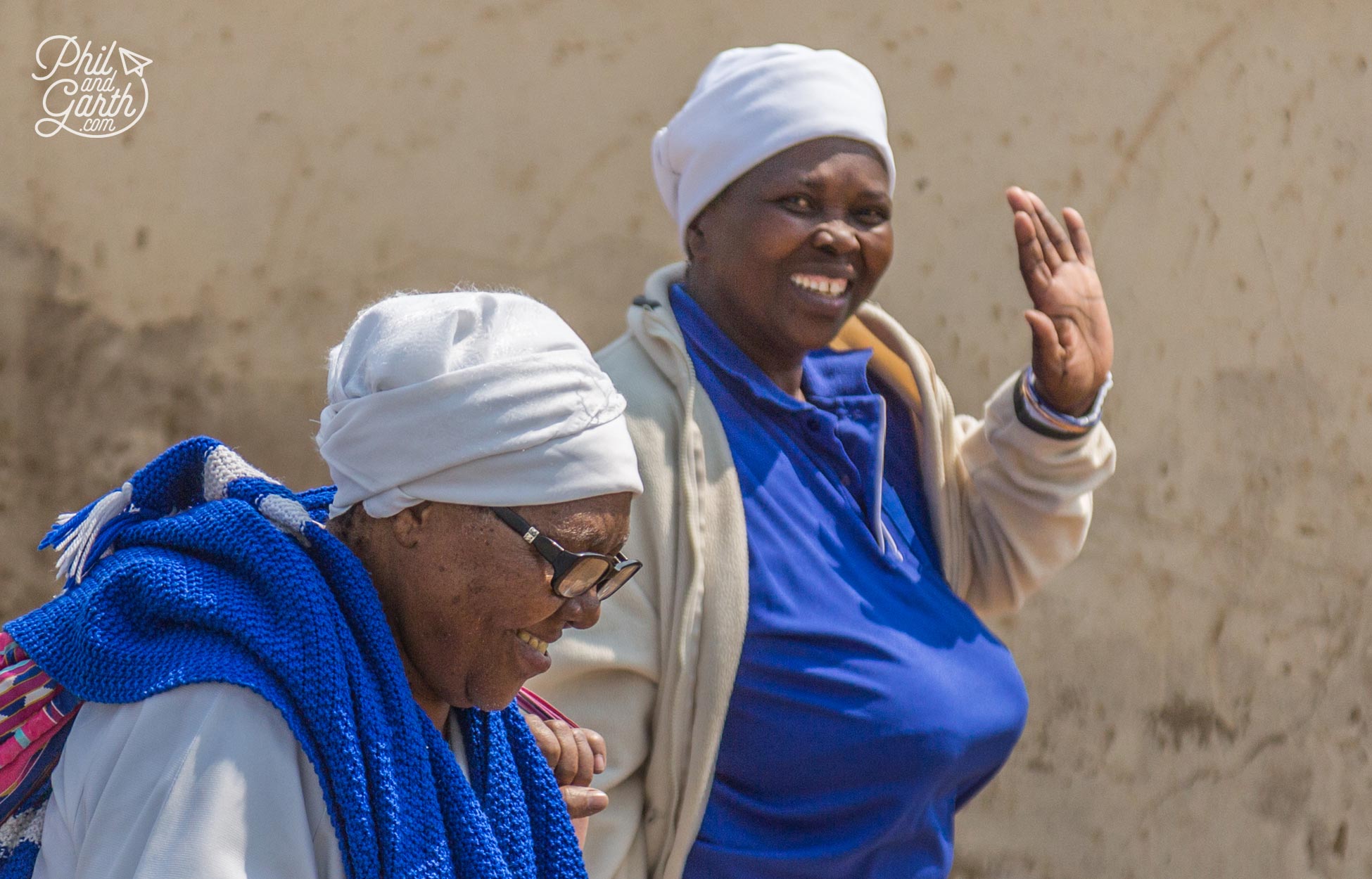
Friendly locals wave to us
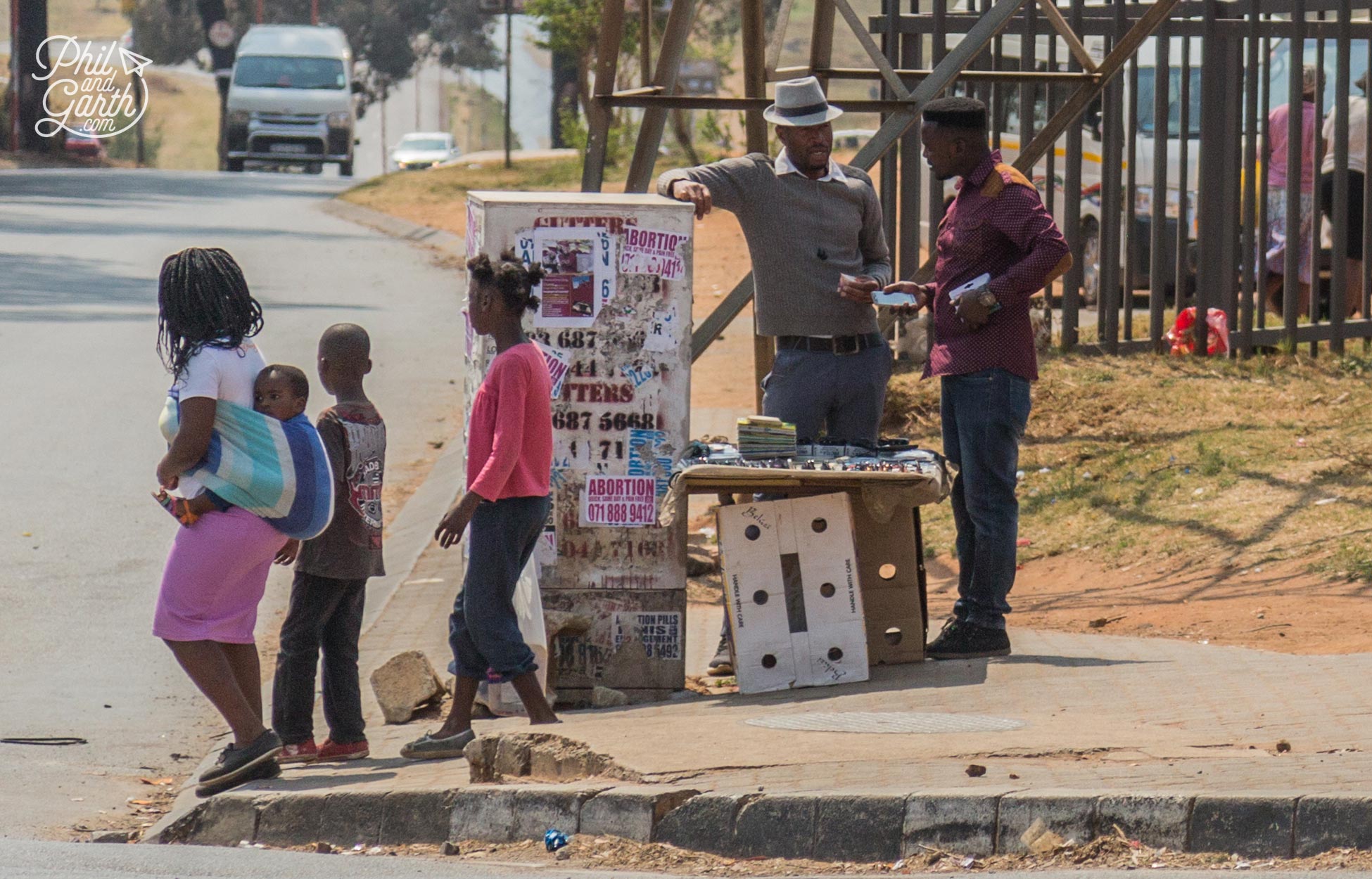
Street vendors are on every corner
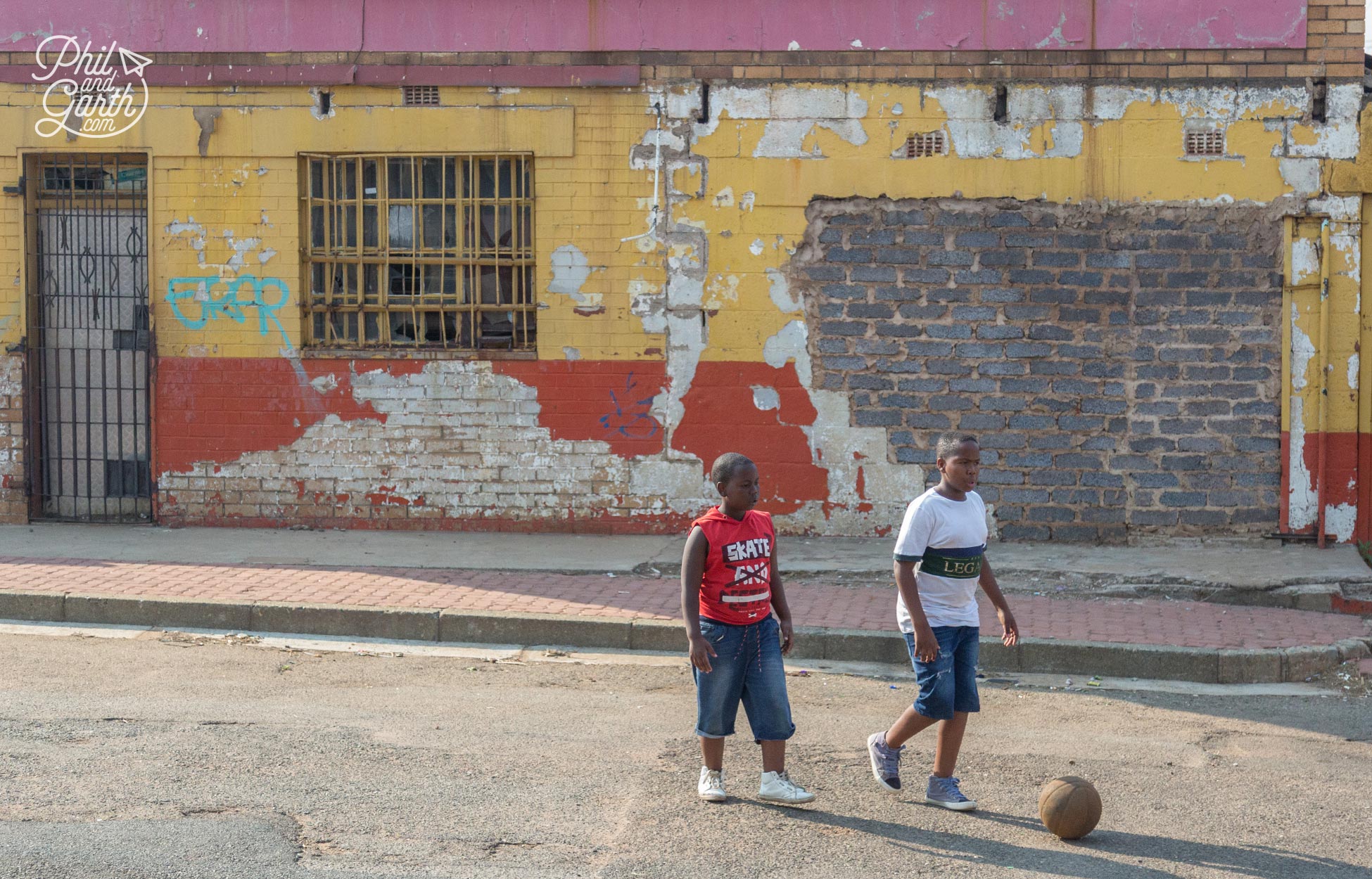
Children playing football in the streets of Soweto
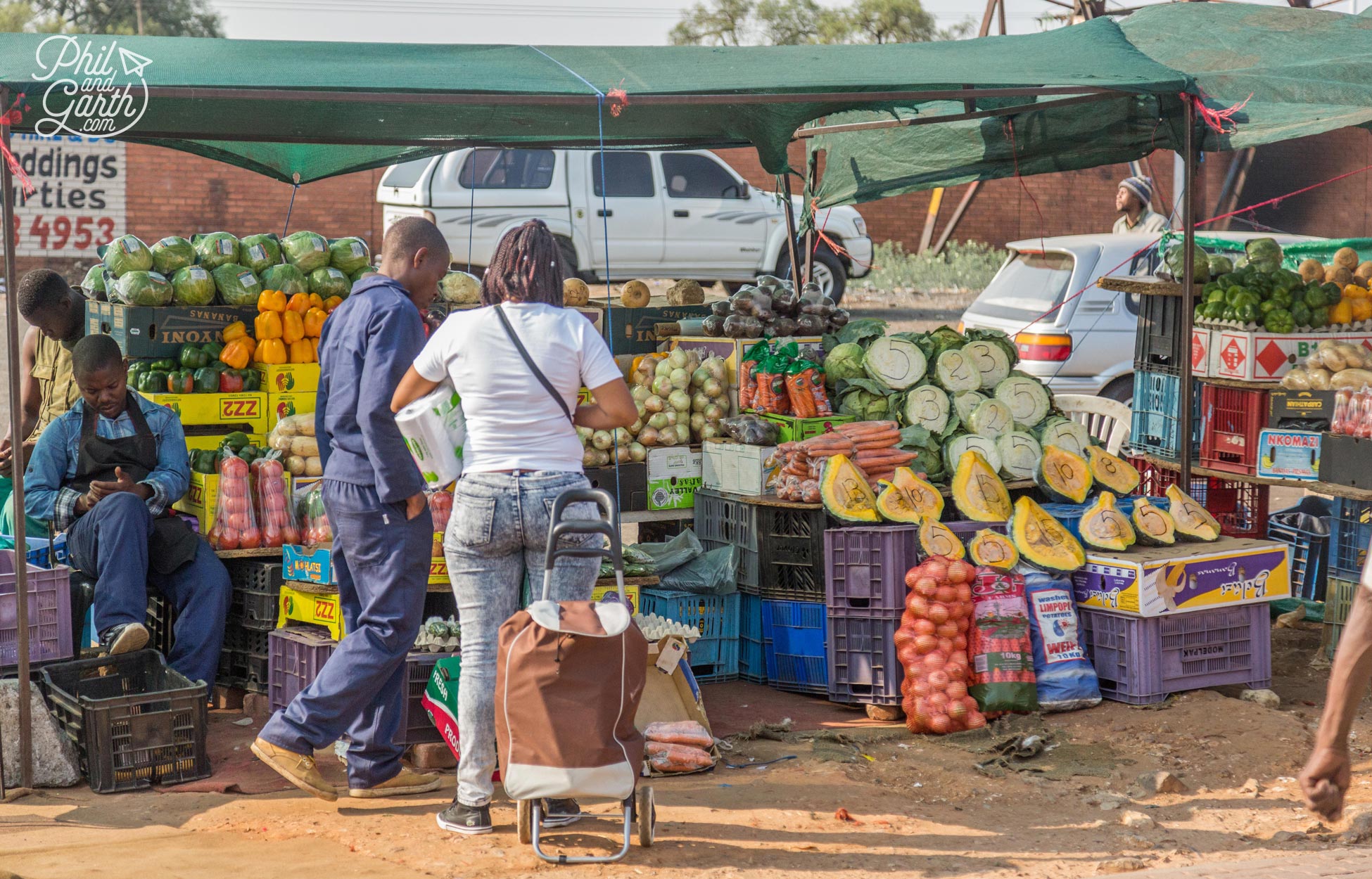
A fruit and veg stall in Soweto
The roads are not great in this part of Johannesburg so be prepared for a bit of a bumpy ride in parts. Our guide started by explaining that Soweto remains a majority black city – a multicultural mix of Zulu, Sotho, Tswana, Venda and Tsonga inhabitants. The city is made up by a number of different townships and has a turbulent history. It was put on the world map when Soweto became the centre of political campaigns, which spread across the country to overthrow apartheid, which we would later learn more about at the museums.
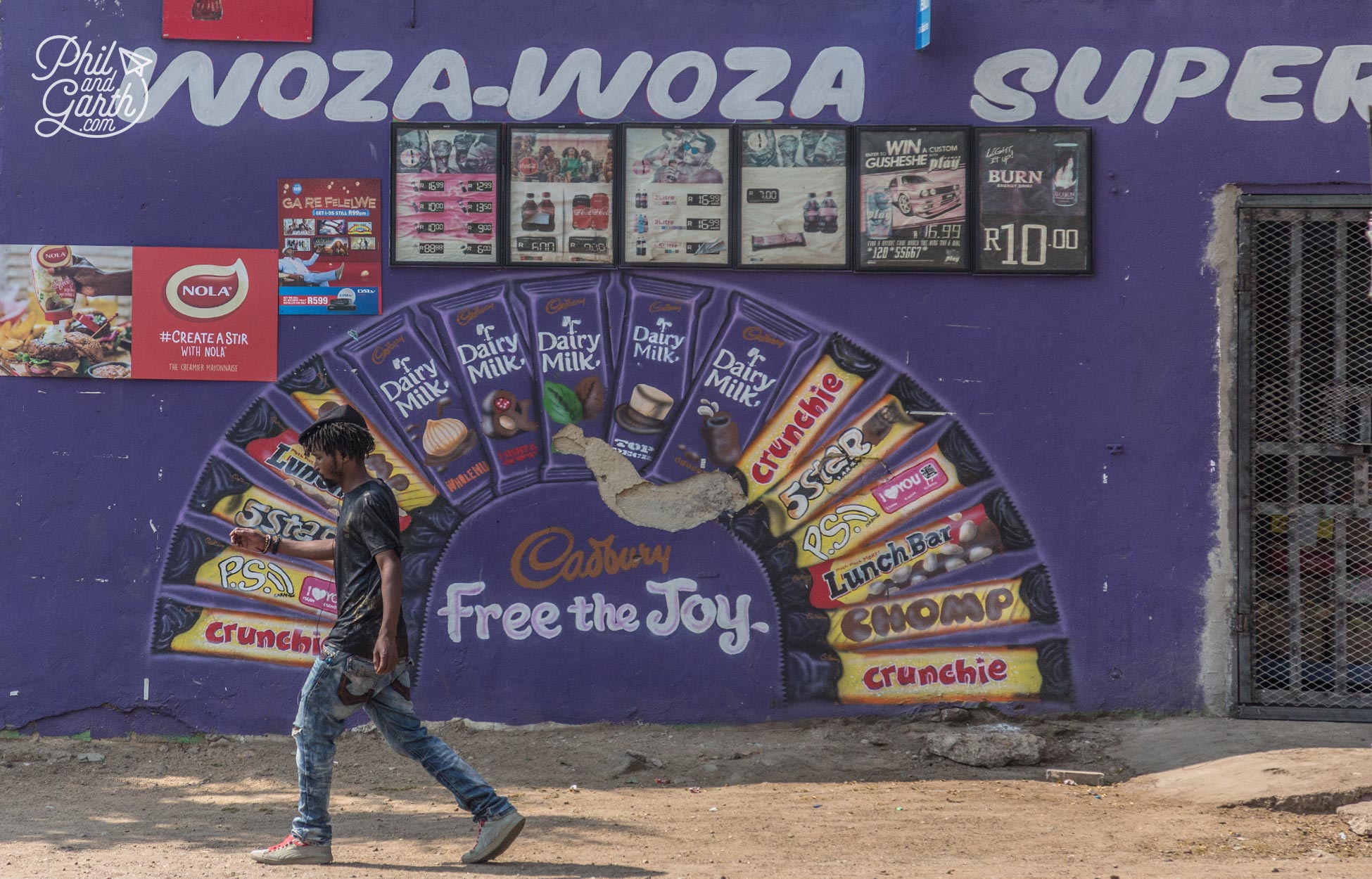
An advert for Cadburys chocolate painted onto a building
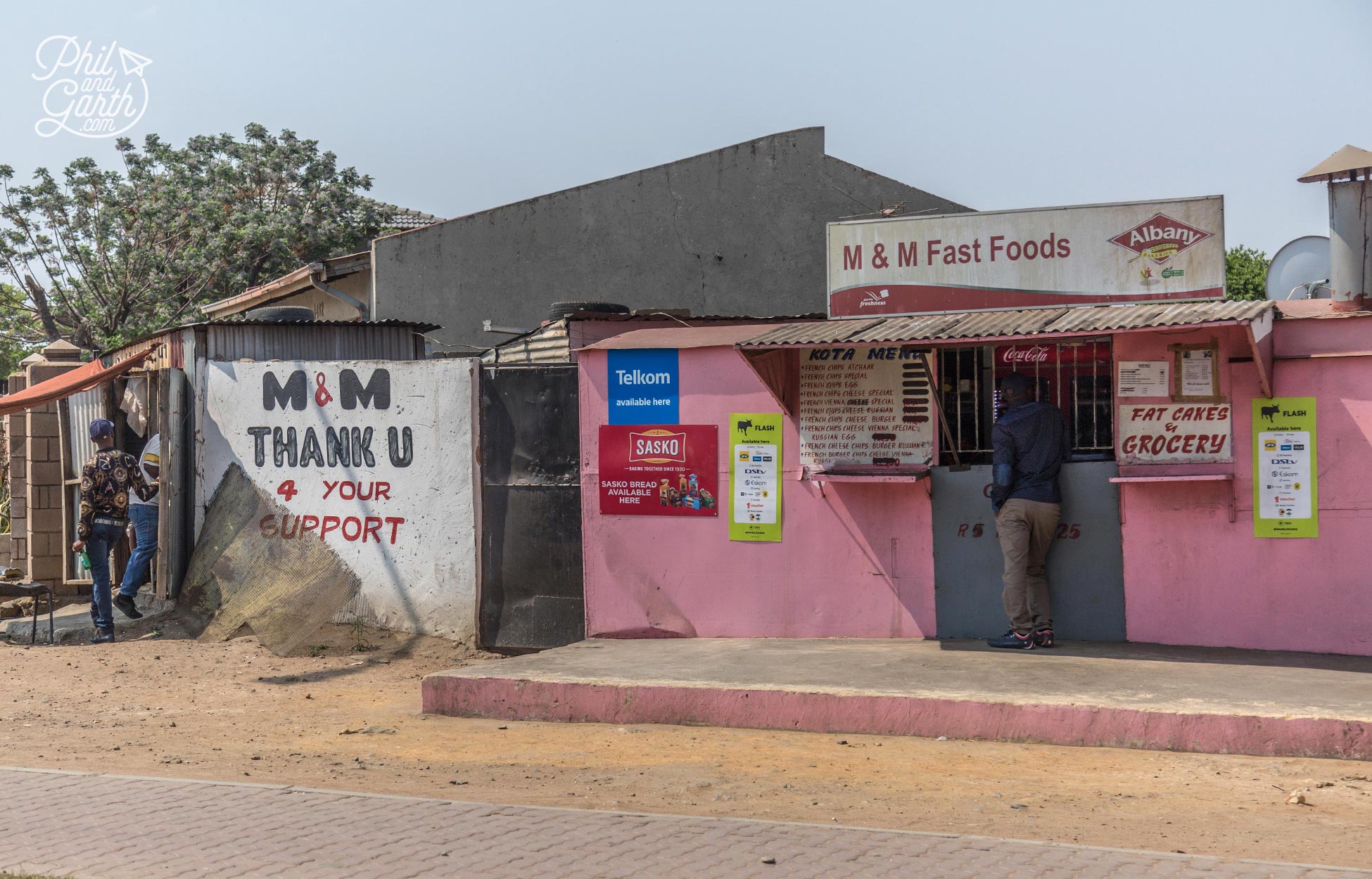
Fast food Soweto style
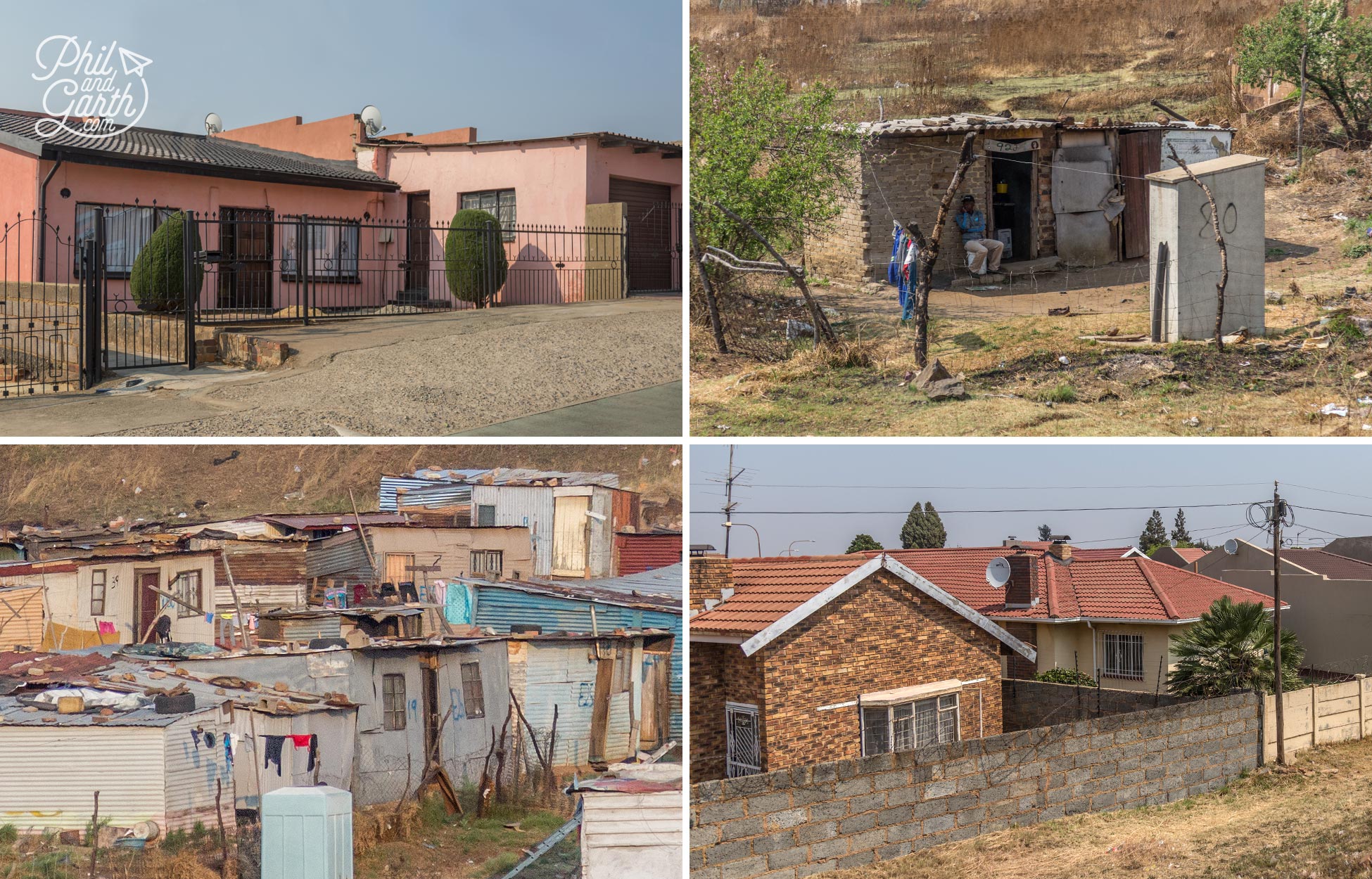
The housing division in Soweto
We were shown many areas, but there was always a common theme – affluent neighbourhoods with brick built homes sit right next to tin shed homes in townships. Not knowing anything about Soweto before we went, we both assumed the whole area would be slums, but it’s really not like that – it’s a real mix of different communities.
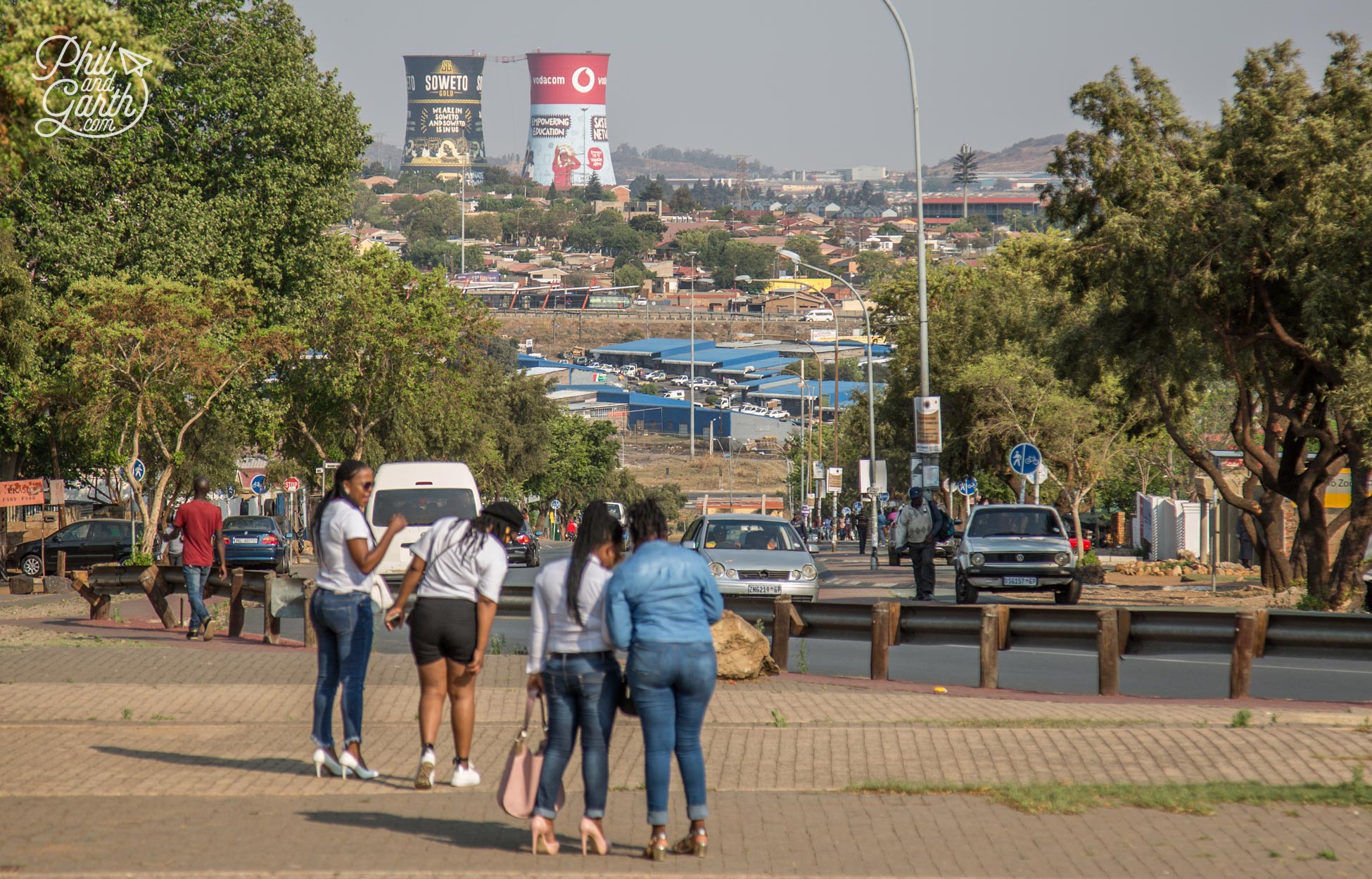
A view across to the landmark cooling towers
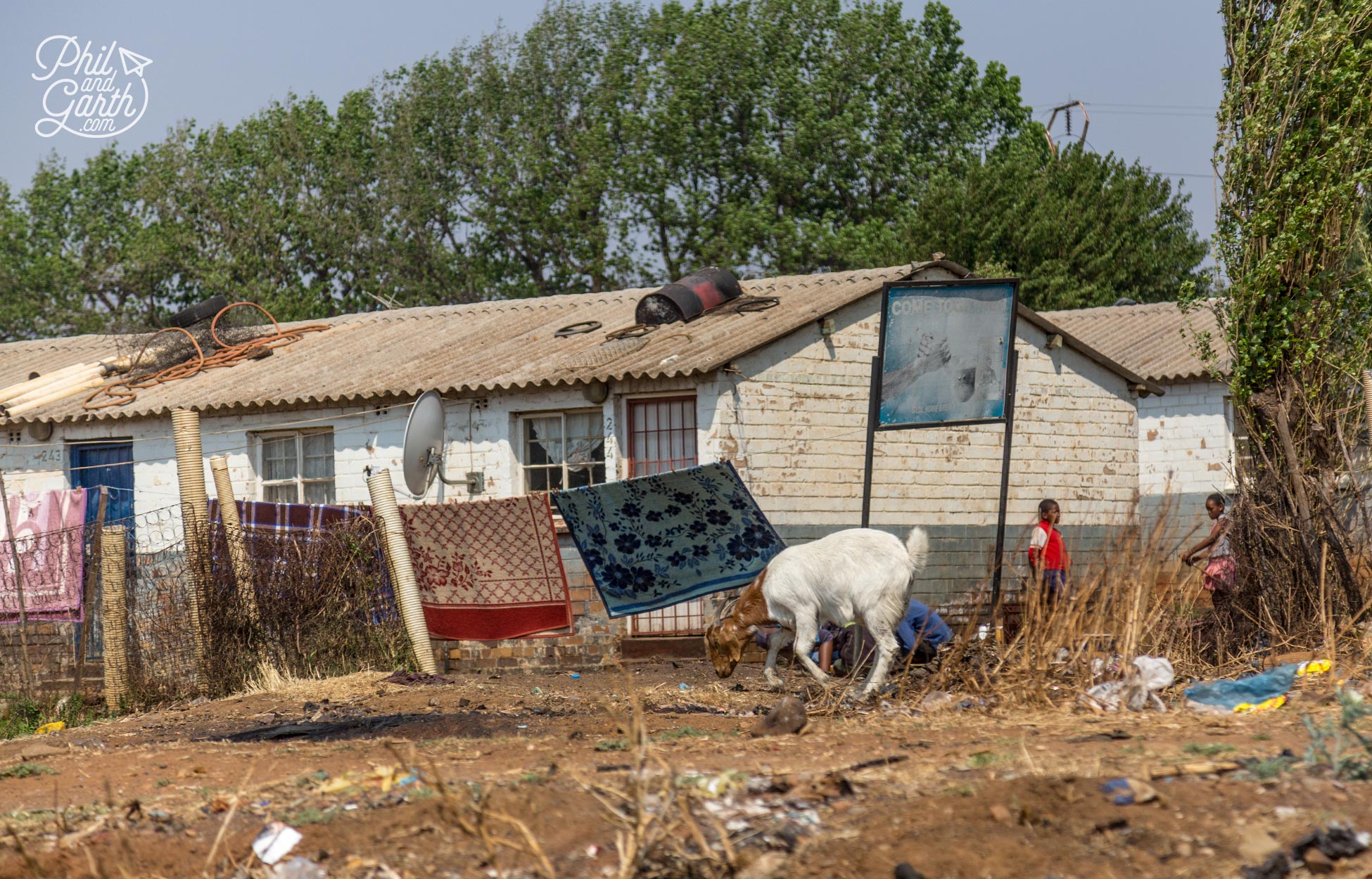
A goat roams the land outside a failed government housing project
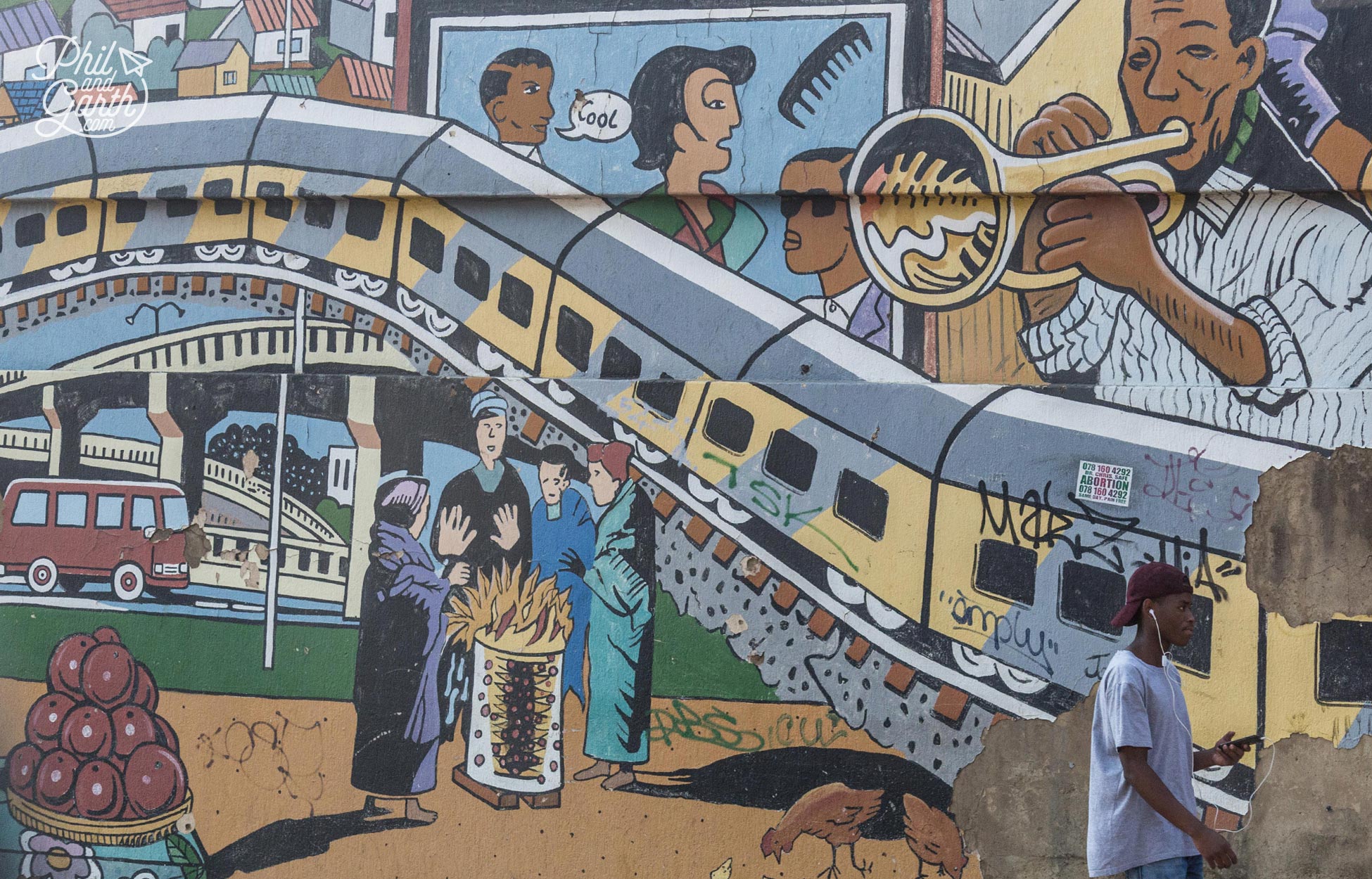
Just one of the many murals in Soweto
Walter Sisulu Square
Our guide met up with a local man who lived in the township next to Walter Sisulu Square, he was brilliant and genuinely eager for us to learn about his life and the history of the Freedom Charter.
The square is right in the middle of a poor area of Soweto, it’s a big empty place. Named after and dedicated to Walter Sisulu, a major anti-apartheid activist who along with Nelson Mandela and 3,000 delegates from other resistance organisations wrote up the Freedom Charter right here in 1955 – a new constitution for human rights, education, health and equality. Sadly apartheid completely took over the country, but the Freedom Charter did go on to become the foundation of South Africa’s constitution in 1996. Let’s hope one day South Africa fully realise these aspirations as intended.
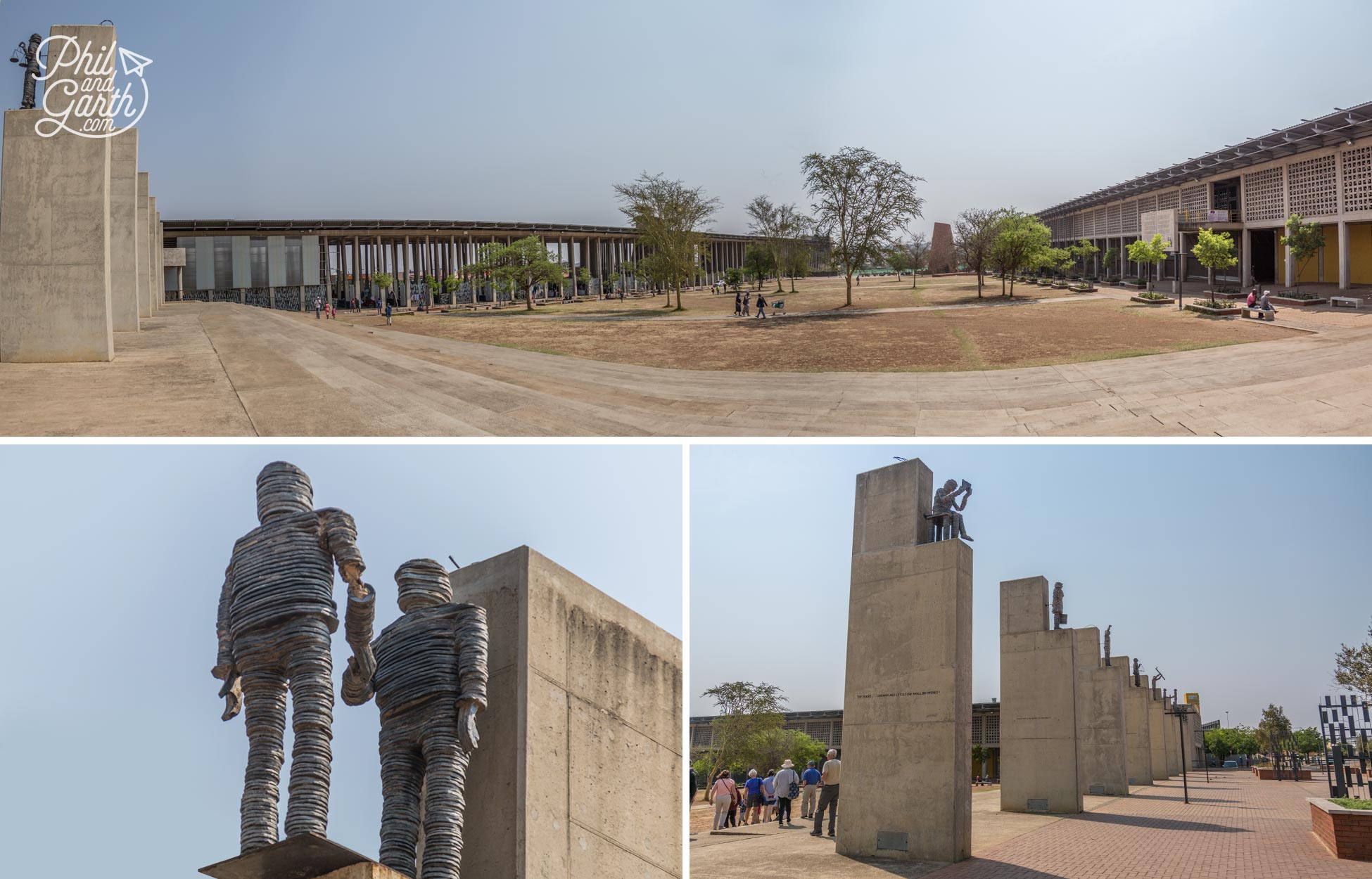
Walter Sisulu Square, Soweto
Around the square are ten statues on columns which represent the 10 pillars of the Freedom Charter:
- The People Shall Govern!
- All National Groups Shall Have Equal Rights!
- The People Shall Share In The Country’s Wealth!
- The Land Shall Be Shared Among Those Who Work It!
- All Shall Be Equal Before The Law!
- All Shall Enjoy Equal Human Rights!
- There Shall Be Work And Security!
- The Doors Of Learning And Of Culture Shall Be Opened!
- There Shall Be Houses, Security And Comfort!
- There Shall Be Peace And Friendship!
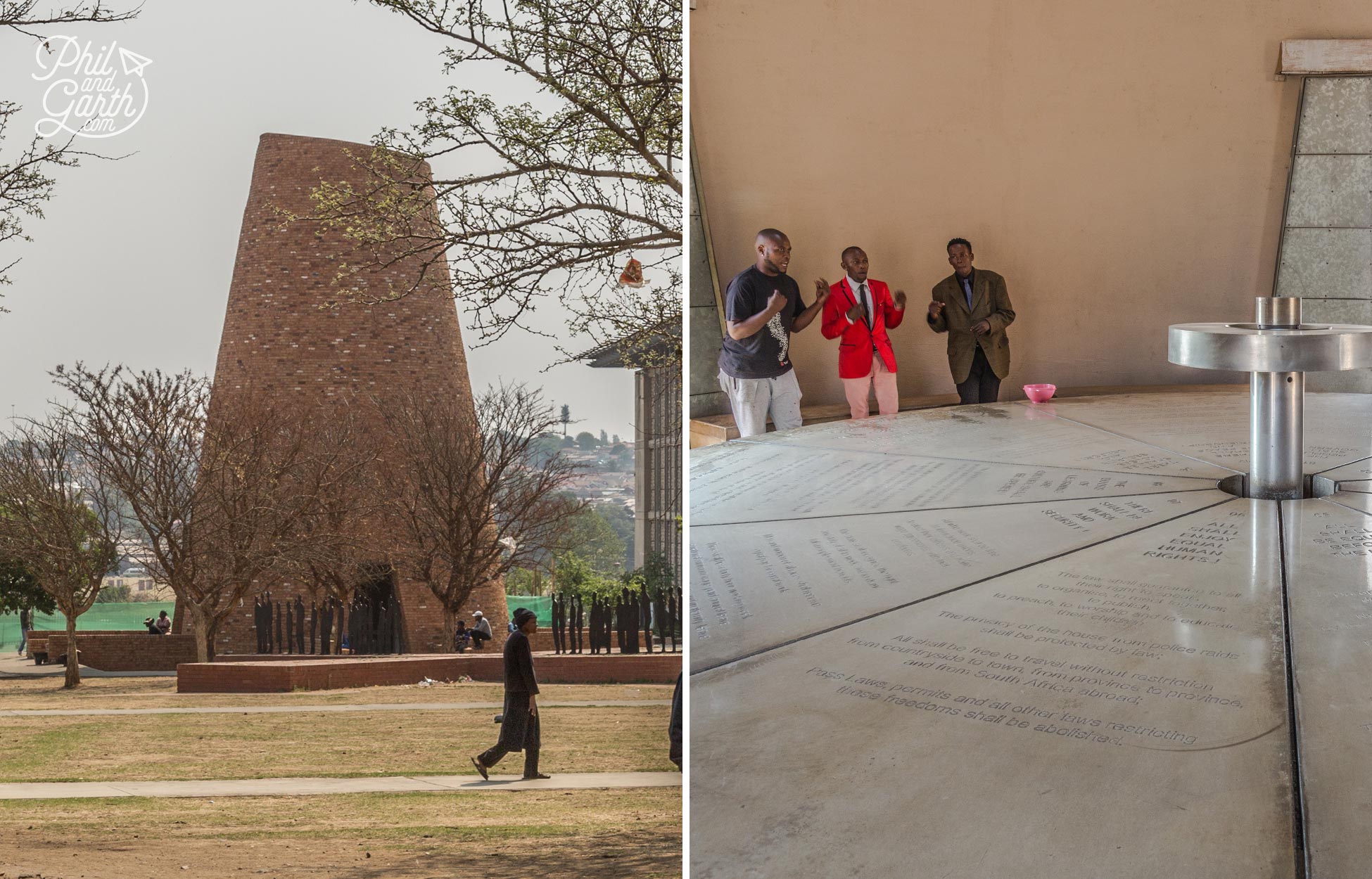
Inside the Freedom Charter Monument
Across the square is the Freedom Charter Monument where inside are extracts of the charter engraved in stone, we listed to some local guys singing a few songs there, nice.
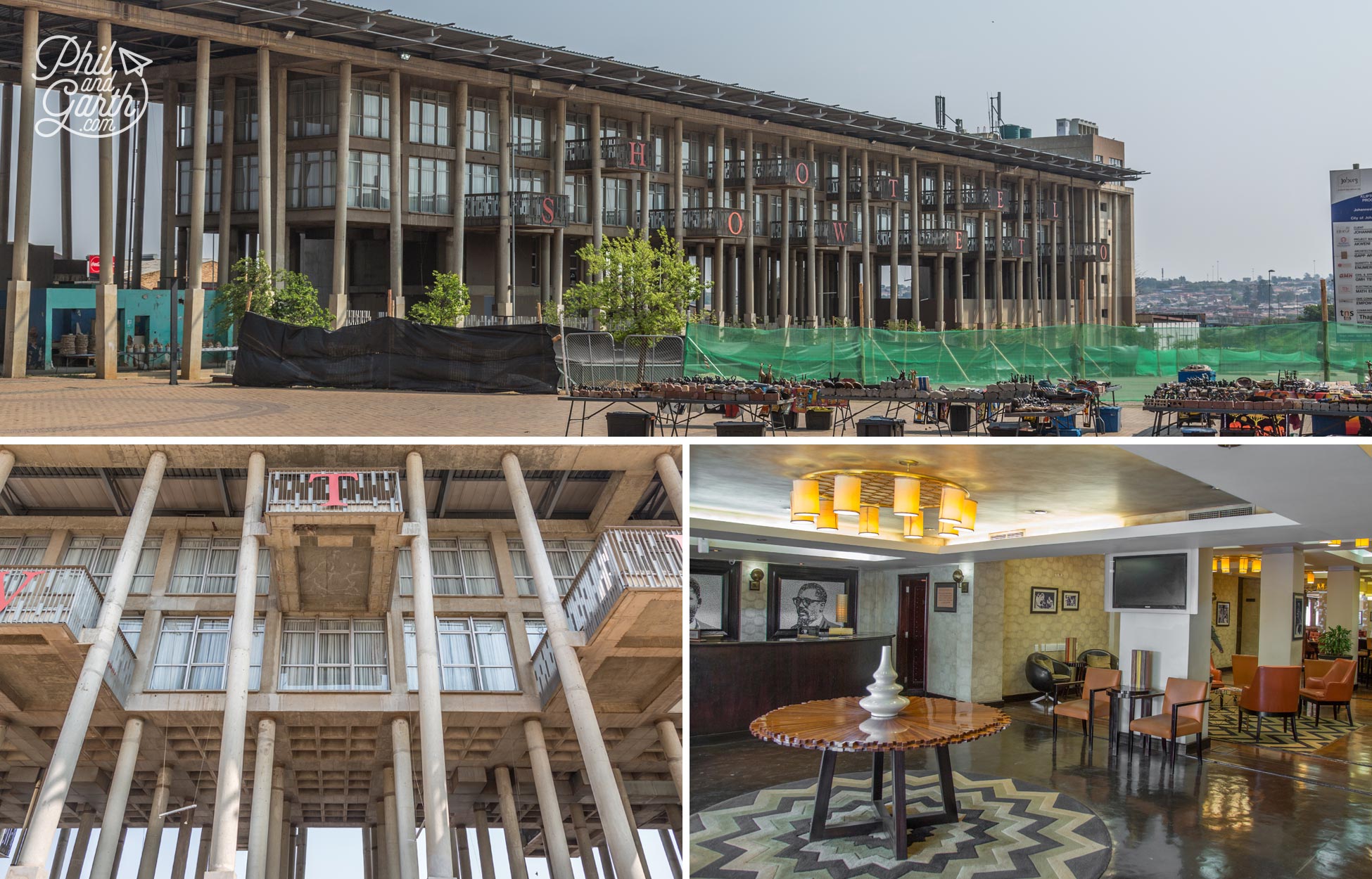
The Soweto Hotel – the only high end hotel in this part of Johannesburg
On the other side of the square is Soweto’s only 4 star hotel. A rather ugly Brutalist concrete building, but home to some luxury rooms where royalty have stayed – Prince Charles and Camilla stayed on a visit in 2011.
Underneath the hotel are several street vendors and a local market, where we saw these unusual wreaths for sale – made from wild sage and herbs which people burn inside their homes to ward off spirits and cleanse the air.
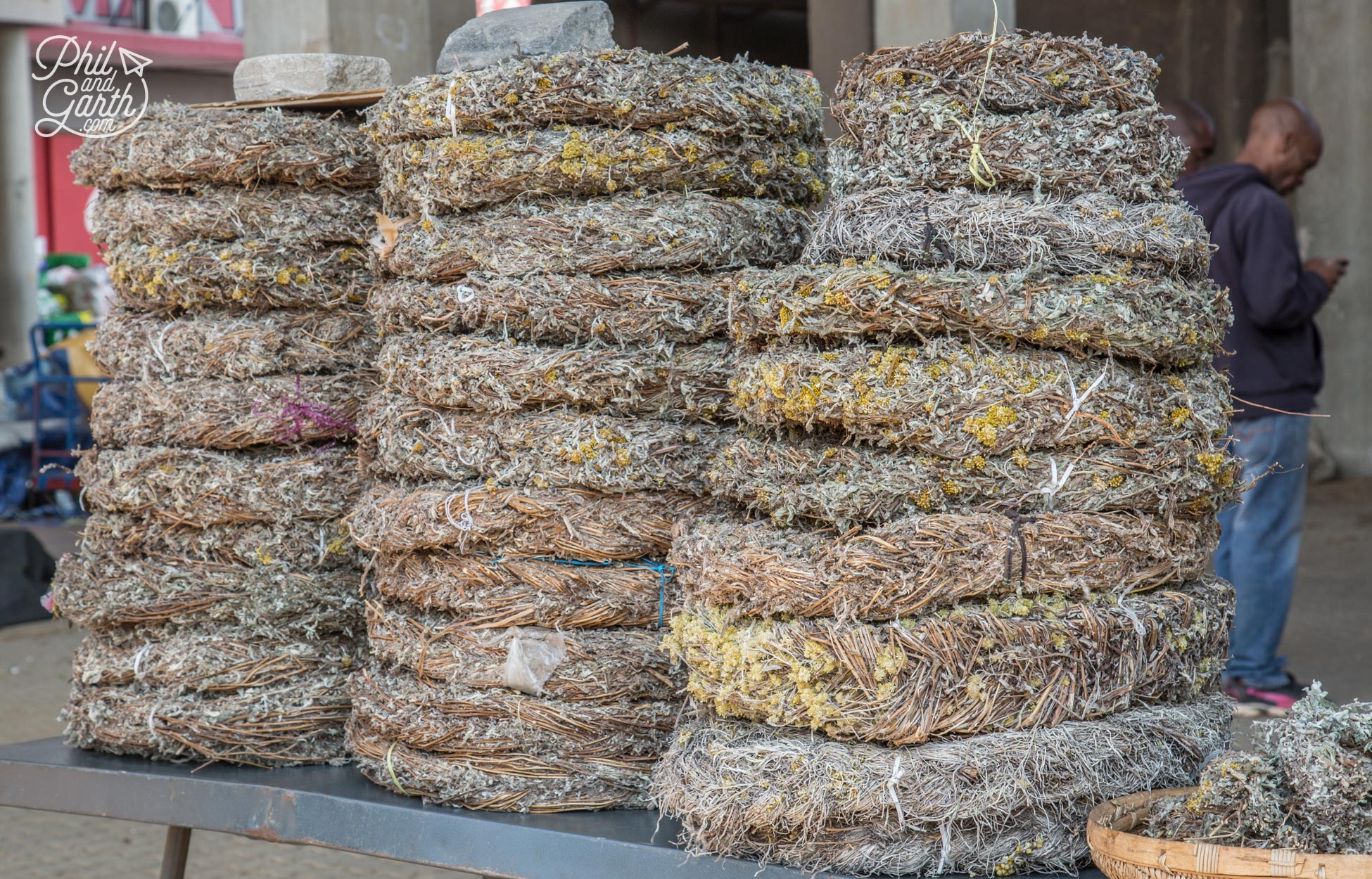
Wreaths made from wild sage and herbs for sale at the local market underneath the hotel
Kliptown township
Our local guide then took us to a nearby bridge to look down on where he lived – Kliptown, a township right next to the square. We didn’t expect to see a township this close up, so this was a real education for us. The whole township uses electricity illegally sourced from the other side of the train track and they have no running water or sewers. Garth asked how much people live on per month – the answer was 1,000 Rand that’s about £60, he also said hunger was an issue, just awful. It’s quite a depressing sight and shocking to witness the miserable conditions people live in. But we have to admit it was somewhat fascinating to see this place as our eyes wandered around the different areas of the township, was this poverty porn? No, we didn’t think so, our guide was proud of where he lived and really keen to answer questions and highlight the issue of poverty in South Africa. He was paid in cash and we were told that money makes it way into his community.
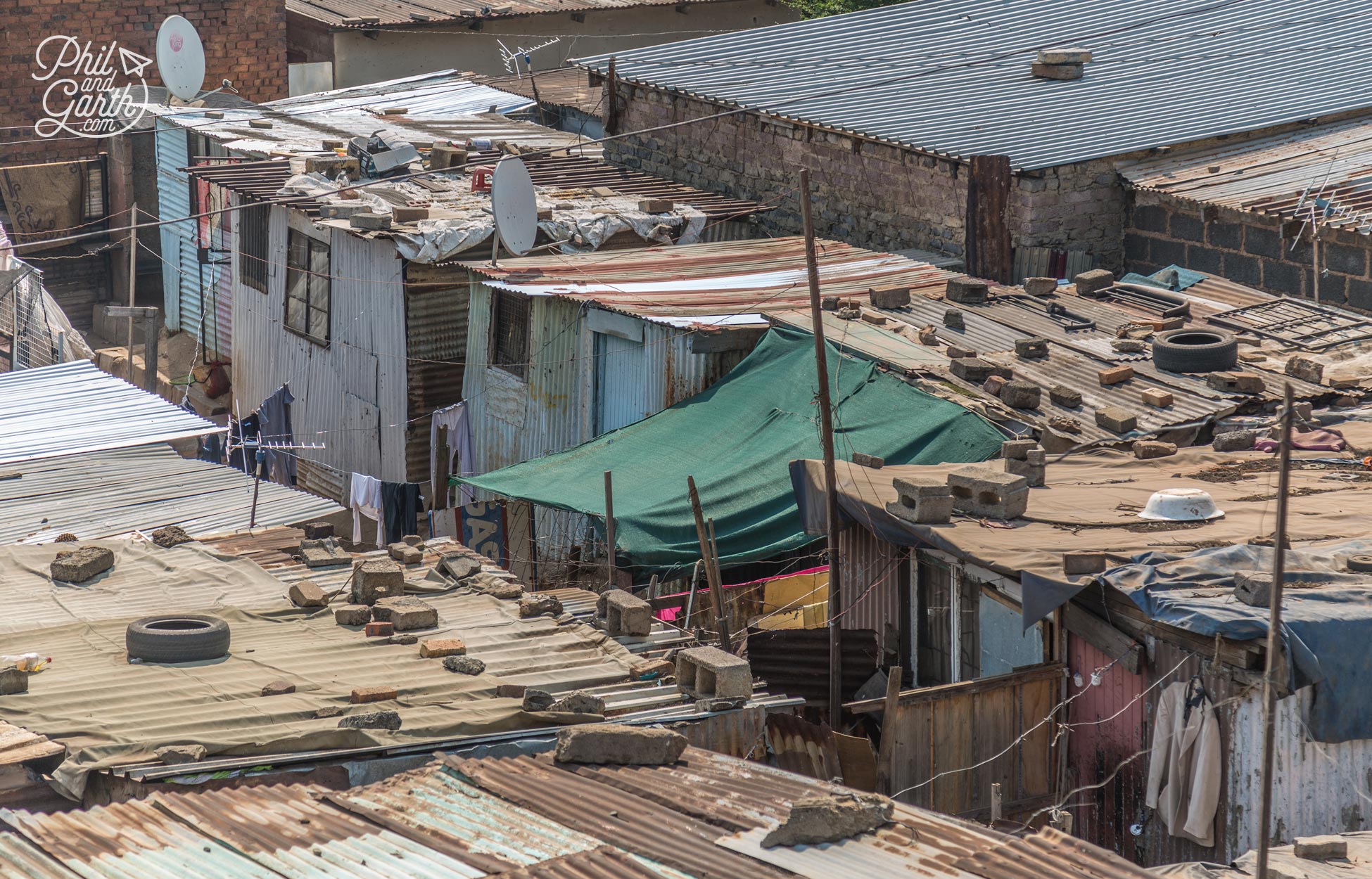
Homes in the Kliptown township
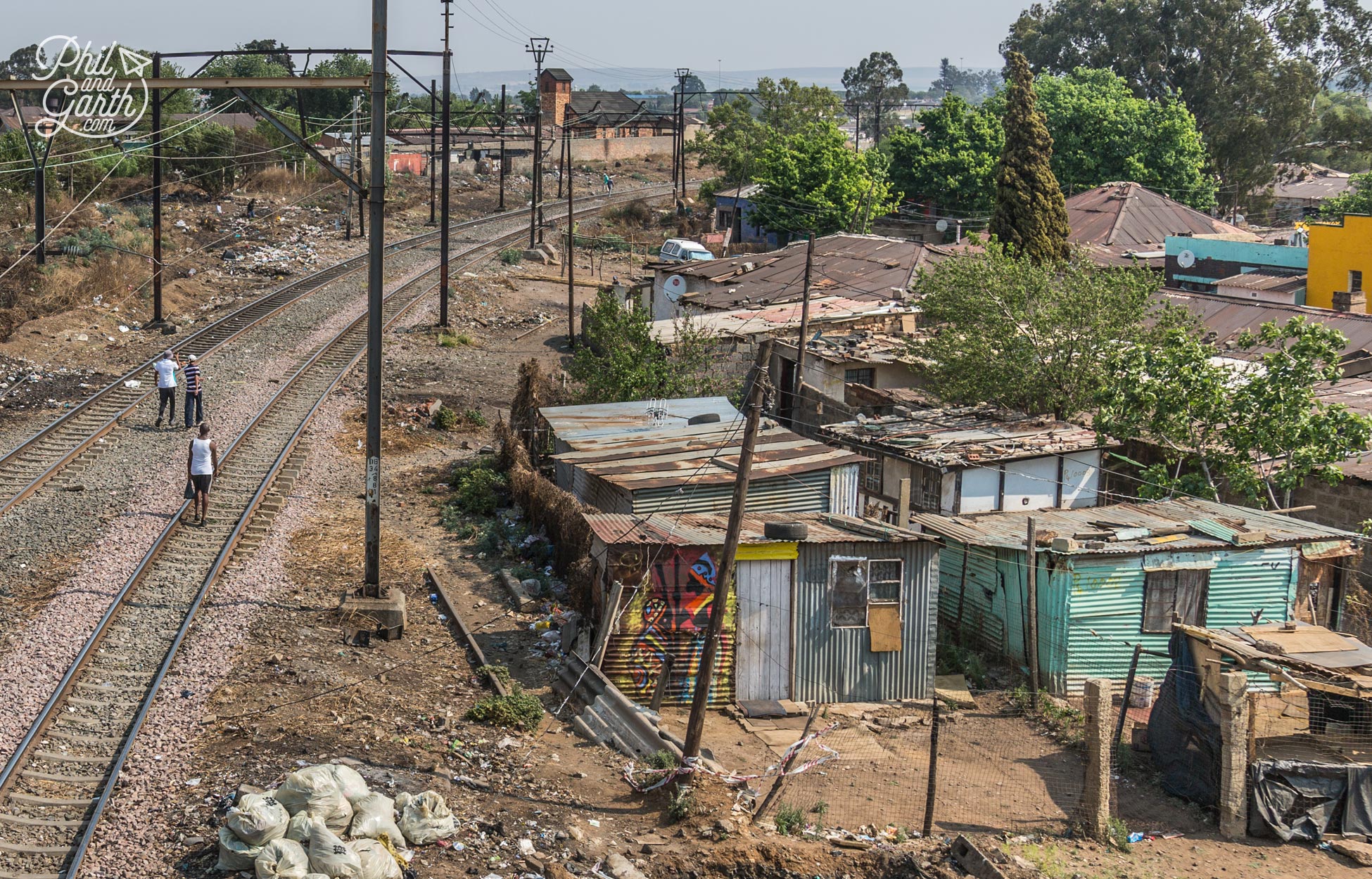
People live in extreme poverty
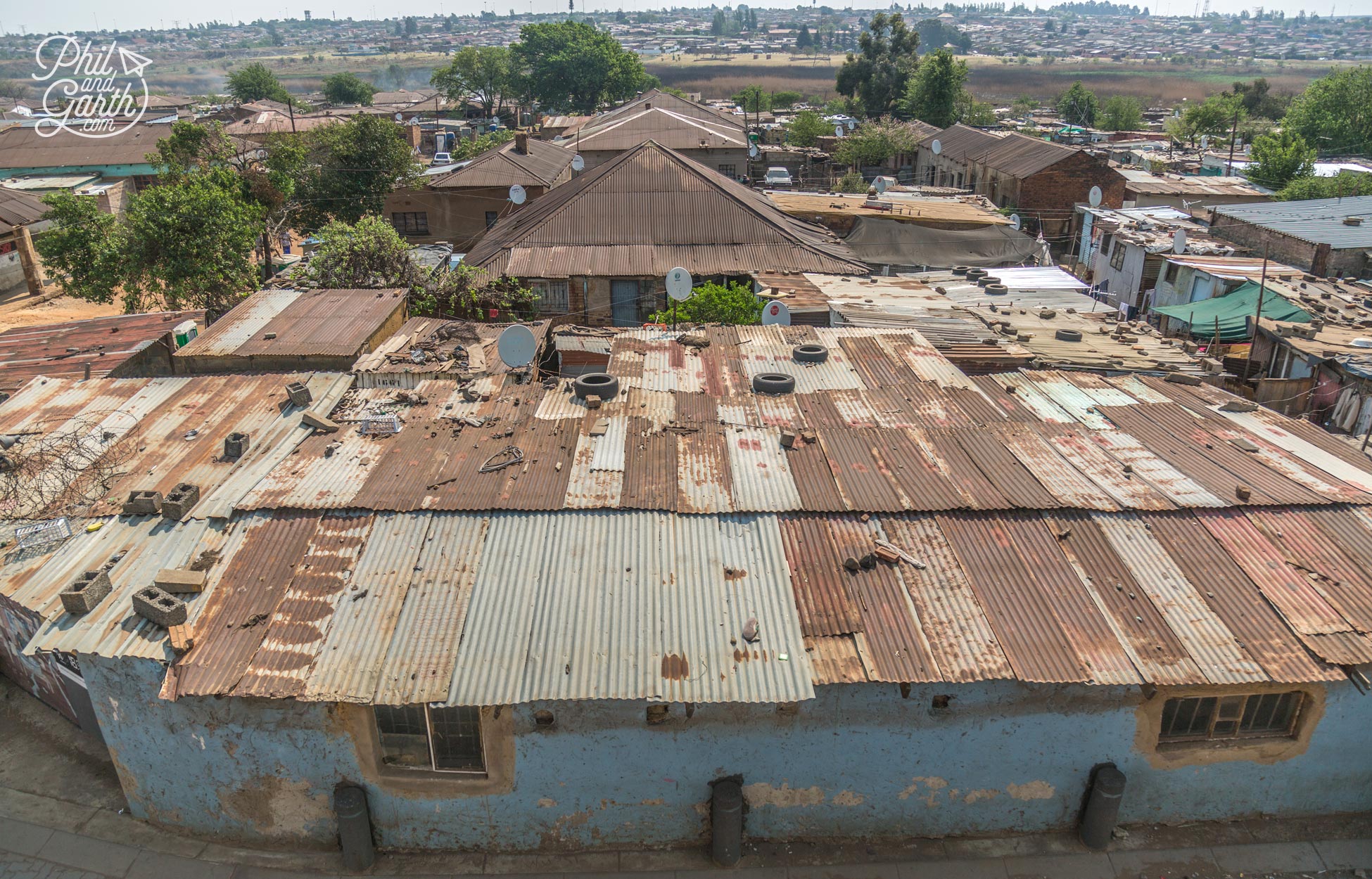
Looking down on the township
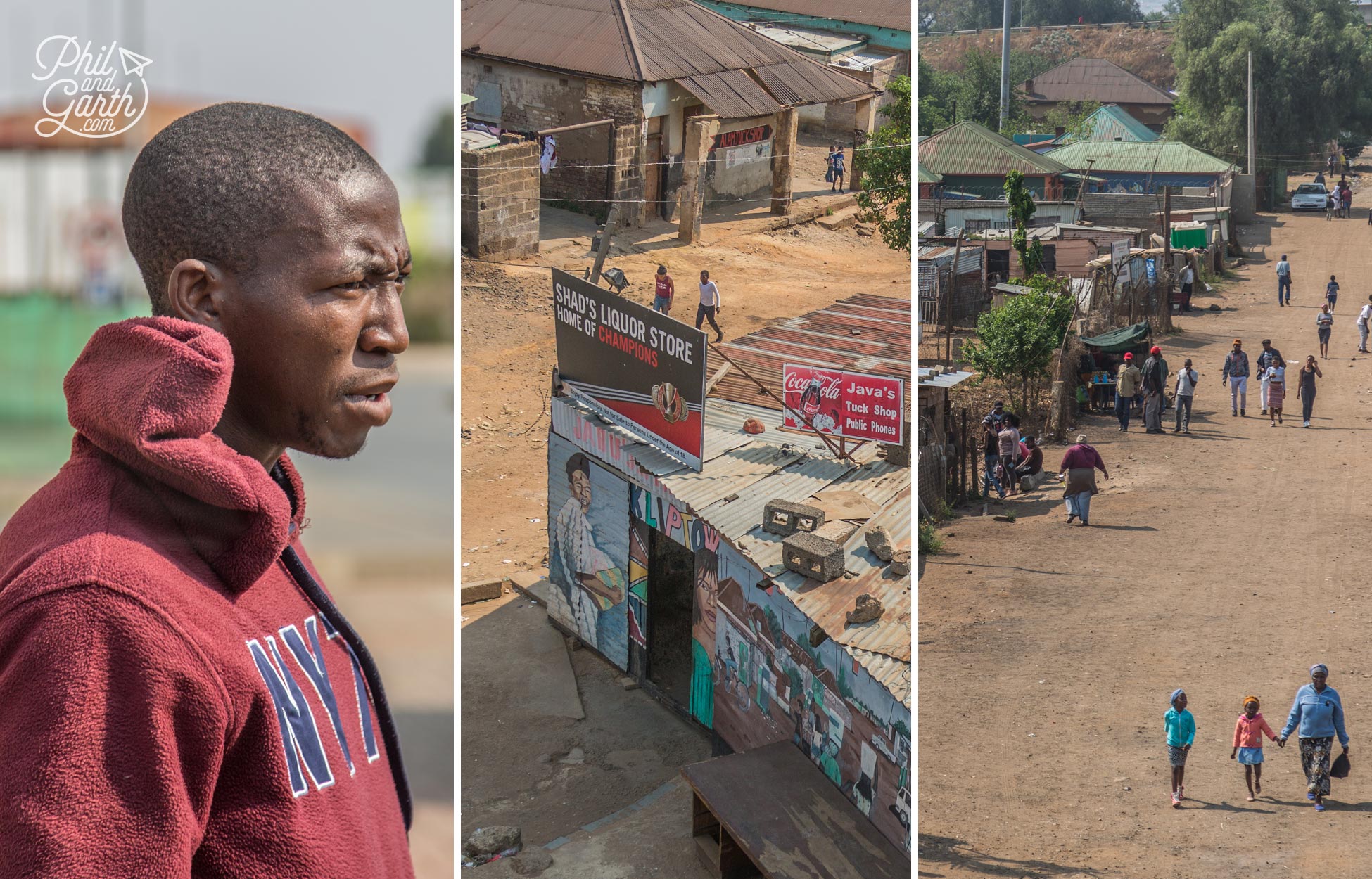
Our guide explains what its like to live in a township
The township tour was a sobering experience, we did leave here questioning the government – do they really care? they seem to be failing the people they liberated from apartheid. For such a developed country how can half the population be allowed to live in such poverty?
June 16 Memorial Acre
Next up we visited an open air memorial dedicated to the Soweto uprising. On the 16th June 1976 15,000 students from schools across Soweto led a peaceful march protesting against apartheid education. The government ruled that schools should teach in Afrikaans for certain subjects, but the children wanted to be taught in English as they felt Afrikaans would limit their future and believed Afrikaans was the language of white supremacists. The student protestors were marching to a stadium and on the way were met by police where a violent confrontation happened. The police shot at the innocent schoolchildren and used tear gas, 176 students were killed, 23 on the first day and more than 1,000 injured. Our guide who was in his 40s and remembered the event as a child, said the real death toll is believed to be around 600+.
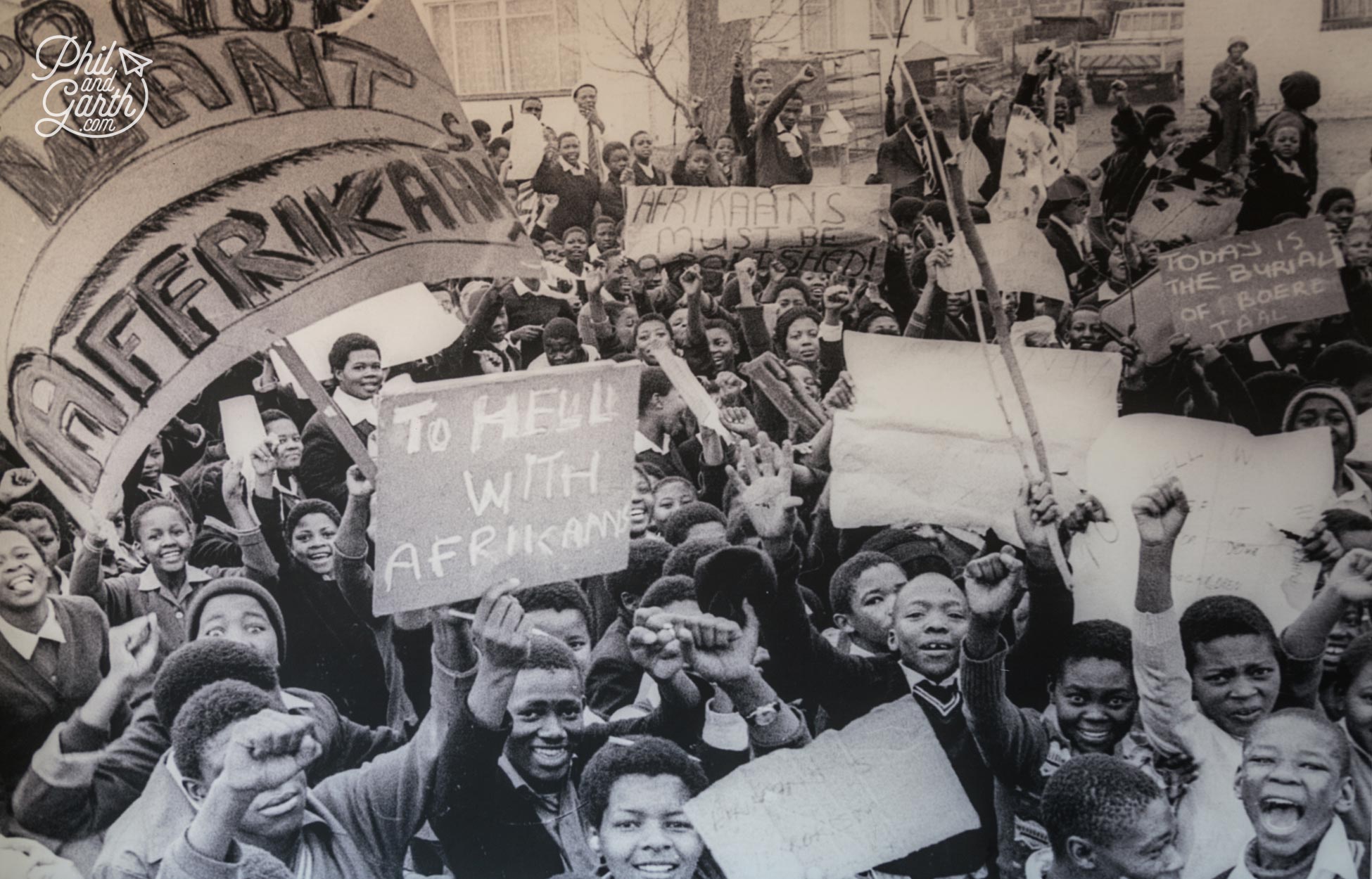
The schoolchildren of Soweto marching on June 16th 1976
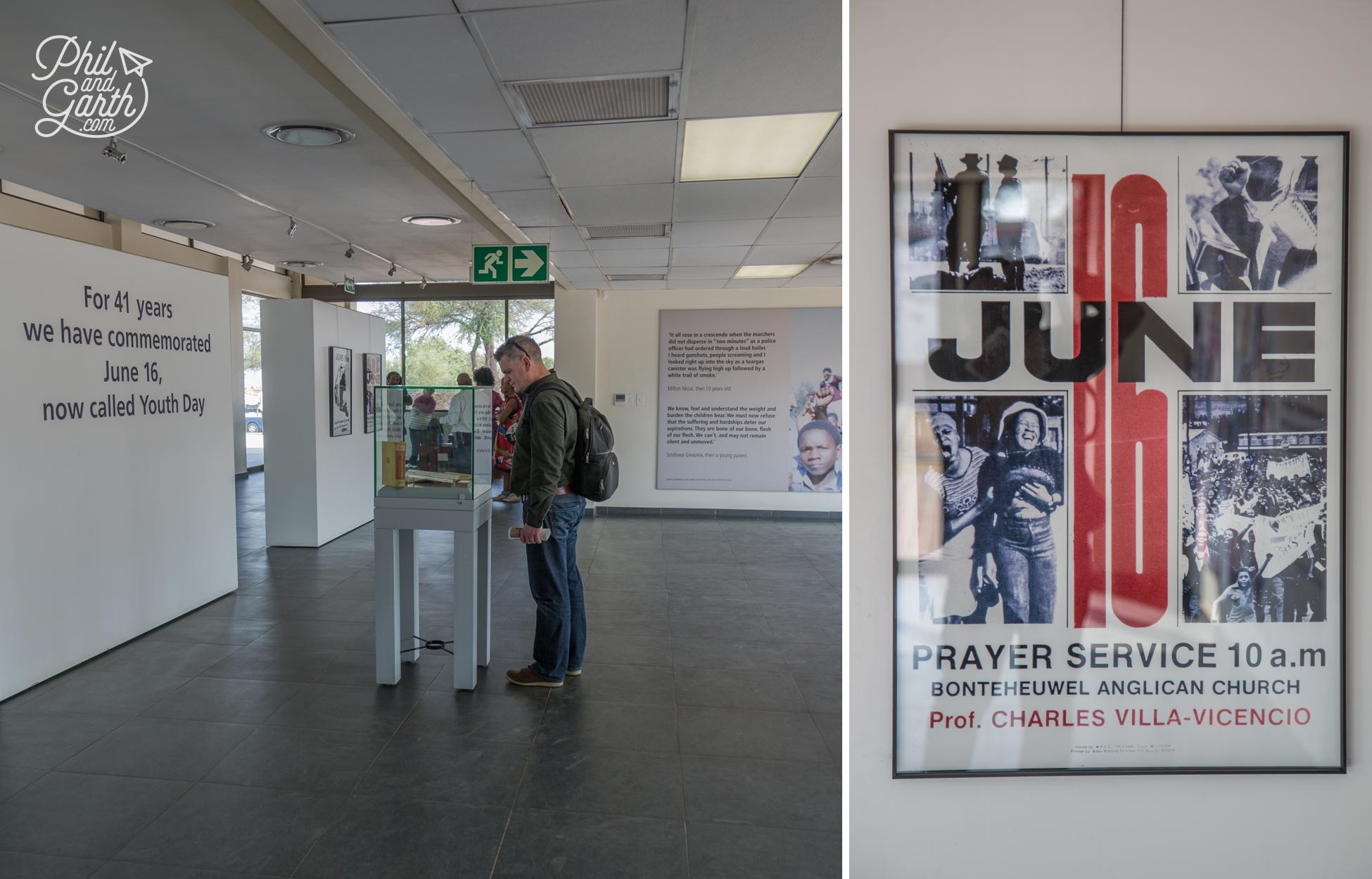
Phil reading about the events of June 16th in the display area
Inside are powerful photographs from June 16th 1976, and outside the story is told through contemporary artwork and murals which explain what happened hour by hour. Outside various contemporary artworks commemorate the eventful day and embrace the heroes. In front of the main building is a statue of Tsietsi Mashinini who was one of the leaders who led the peaceful student protest.
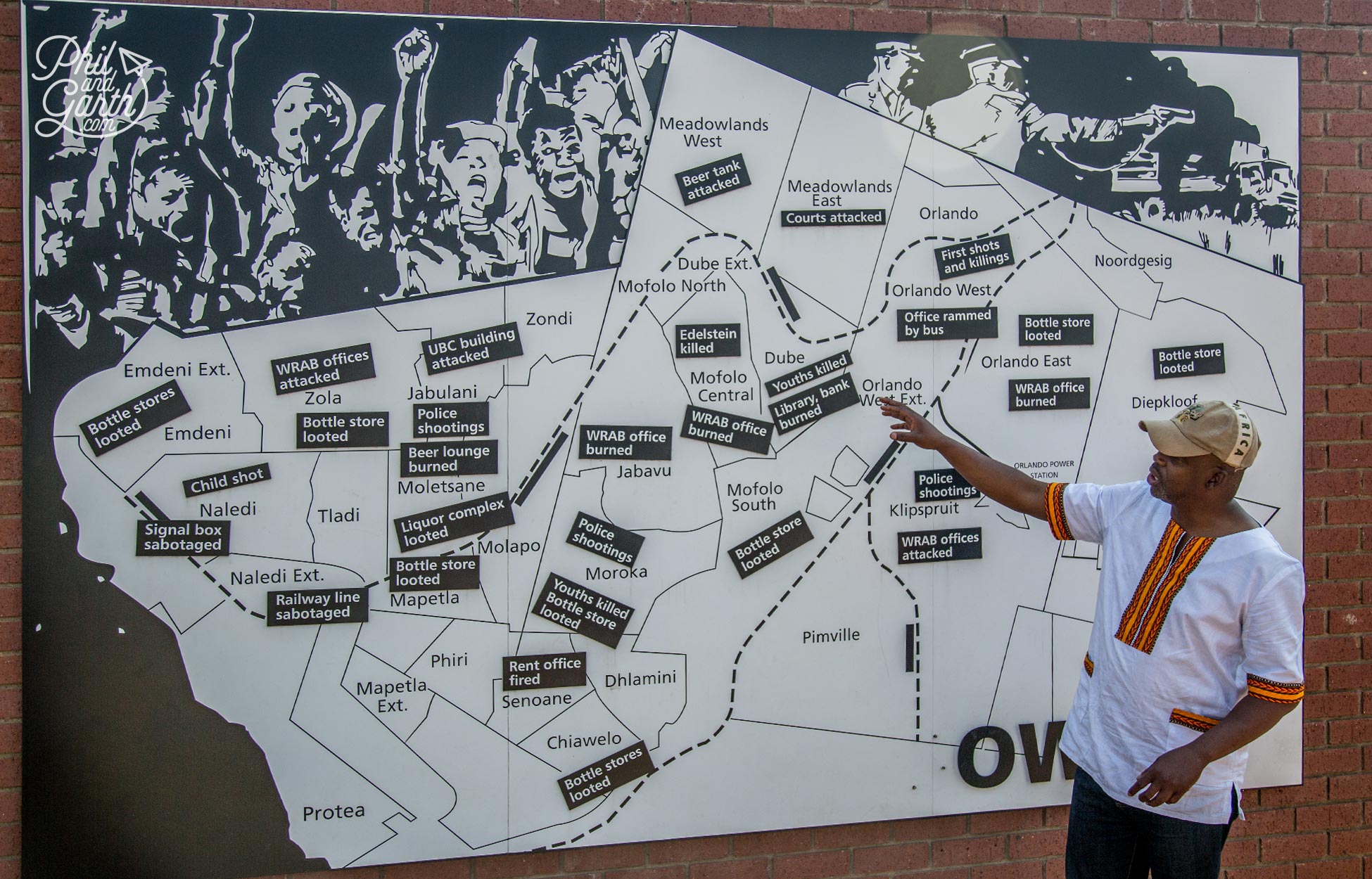
Our guide explains what happened against a newspaper illustrated map.
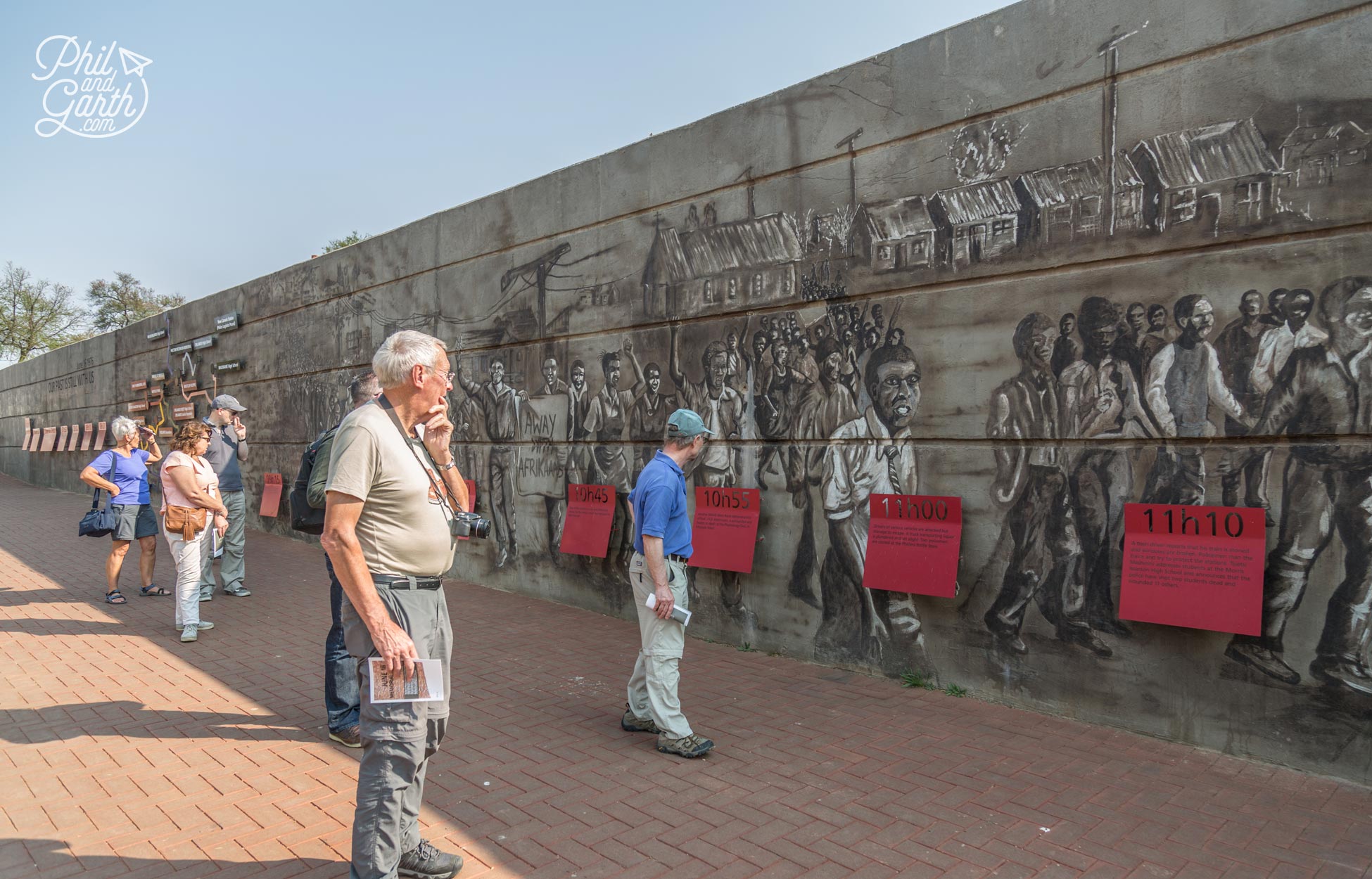
A timeline of events justifying the police actions. A one sided government view
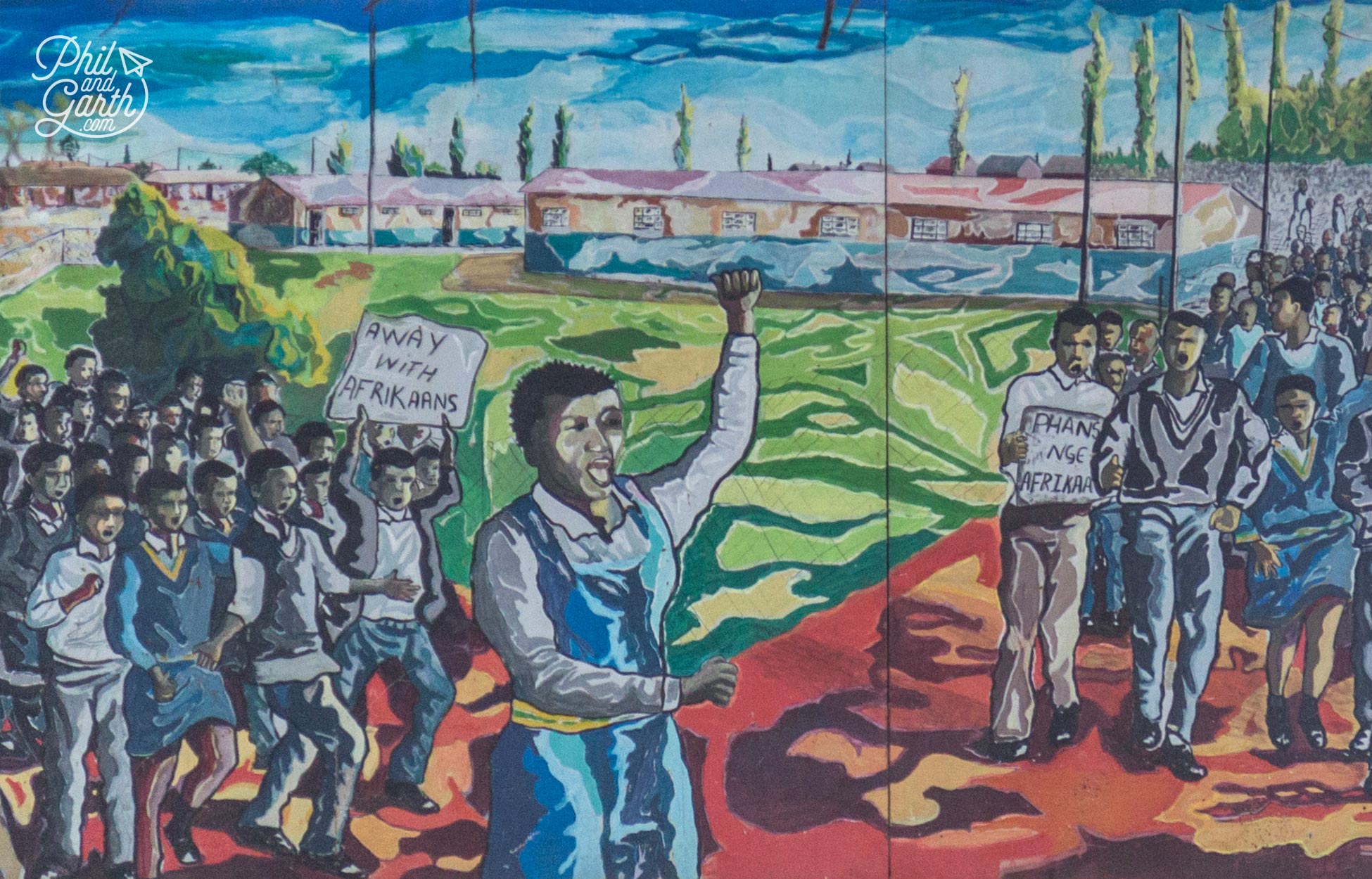
‘Marching For Freedom’ – an artwork depicts the scene of local schoolchildren
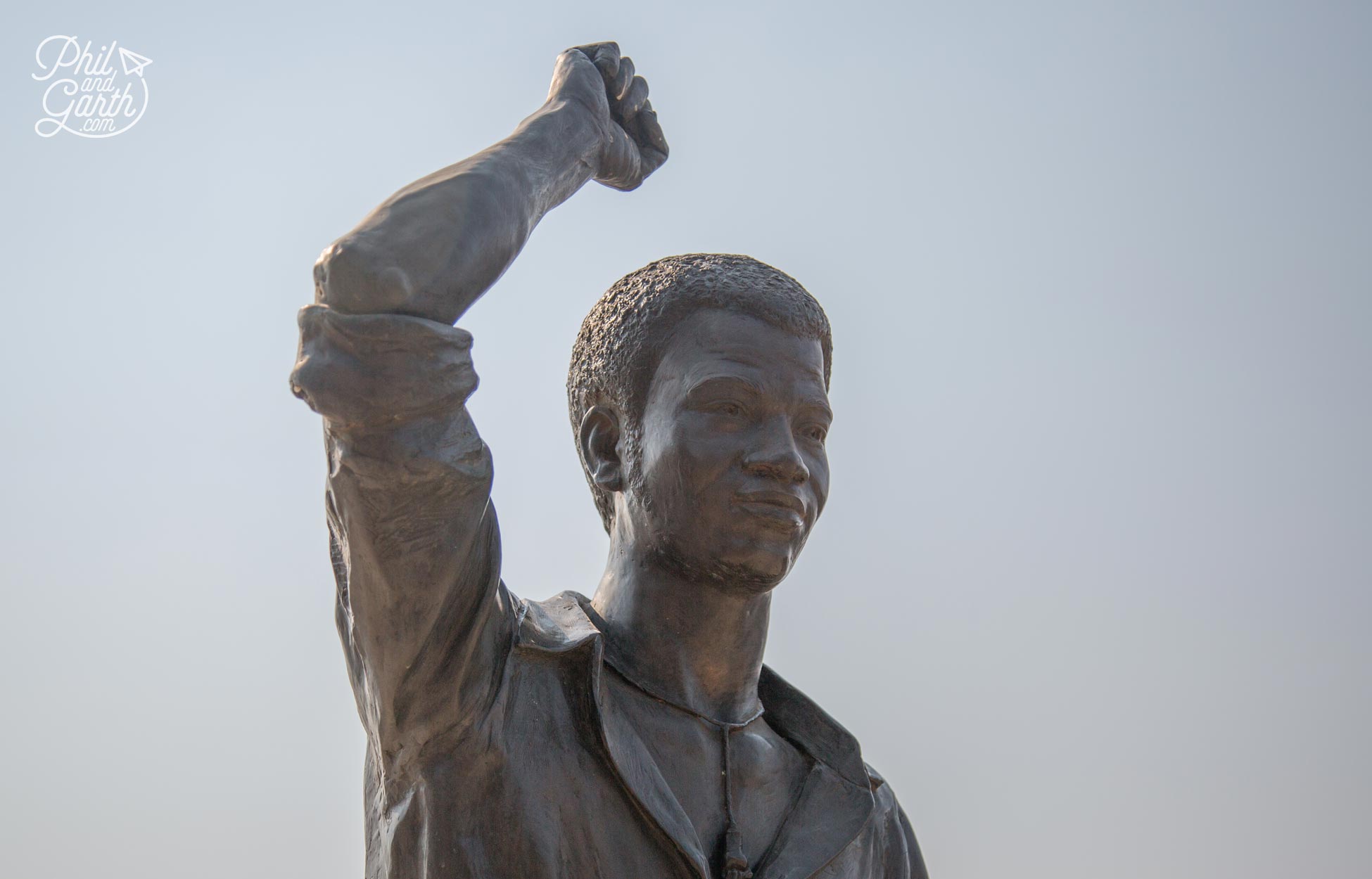
Statue of Tsietsi Mashinini one of the leaders who led the peaceful student protest
June 16th is now called ‘Youth Day’ – a public holiday in South Africa dedicated to the students who sacrificed their lives in the name of equality. We have to admit we had never heard of this tragic day and the events that happened, but after visiting the memorial we won’t forget the schoolchildren.
Hector Pieterson Memorial and Museum
A short minibus ride away is the Hector Pieterson Memorial and Museum where we would learn more about June 16th 1976. Dedicated to Hector Pieterson, believed to be the first child shot by the police. He was just 13 years old and became a symbol of the Soweto Uprising in 1976. Outside the memorial there’s a fountain with water flowing to the street – symbolising the blood shed from the schoolchildren. Next to the memorial is an iconic photograph of Hector Pieterson’s dying body been carried away by a fellow student. The photograph made newspaper and tv headlines around the world and is said to be as famous as Kim Phuc – the naked girl running away from napalm strikes in the Vietnam War. The photograph is there to show visitors the agony and suffering that the schoolchildren pictured went through on that fateful day.
The museum is located two streets away from where Hector Pieterson was killed. Inside we listened to eye witness accounts, read some heart breaking stories. We both found the museum to be quite exhausting and emotionally draining, perhaps it was too much for one day. Also photography is not allowed inside the museum.
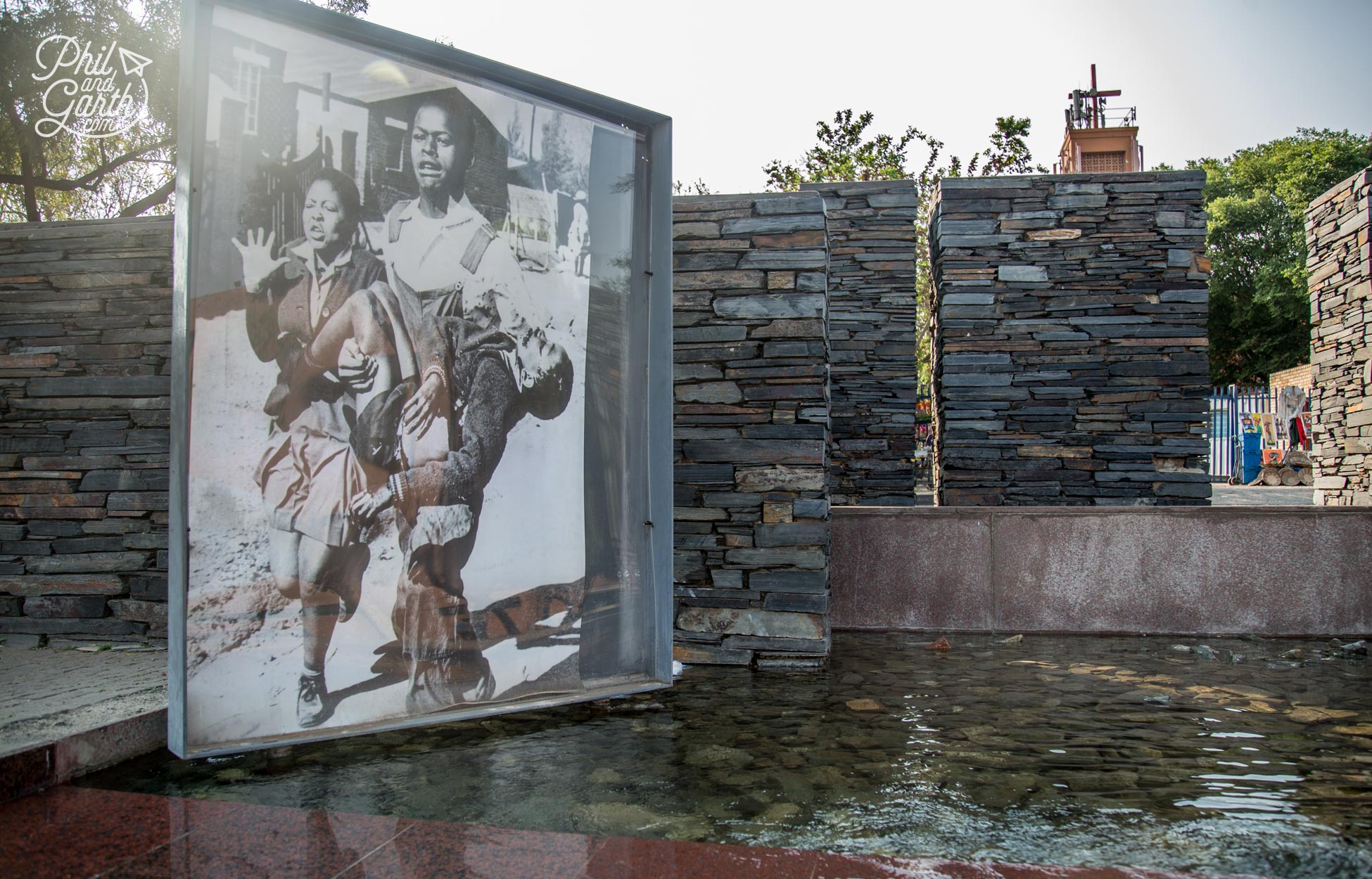
Hector Pieterson Memorial and Museum
Mandela House Museum
Our final stop in Soweto was the Mandela House Museum which was the family home of Nelson Mandela between 1946 – 1991 (he was affectionately known as Madiba). He lived here with his first wife, Evelyn Ntoko and son, then after divorce his second wife Winnie Mandela with their 2 daughters. However he didn’t live here that long when in 1961 was forced to go underground as the most recognised anti-apartheid leader. He was arrested in 1962 and jailed for life and spent 27 years in prison. However Mandela did return to live here for 11 days after his release from prison in 1990. Garth remembered watching for hours his historic release live on tv.
In the 1940s, the government built black-only homes for workers and mockingly called them ‘matchbox houses’ because of their small size. The Mandela house is one of these houses – built in 1945, a modest one story red brick building with 4 rooms, where the inside has been turned into a museum. We viewed photographs and artefacts showcasing his life and period as the President of South Africa. There’s also some unusual gifts such as the world championship belt gifted to Mandela by boxer Sugar Ray Leonard.
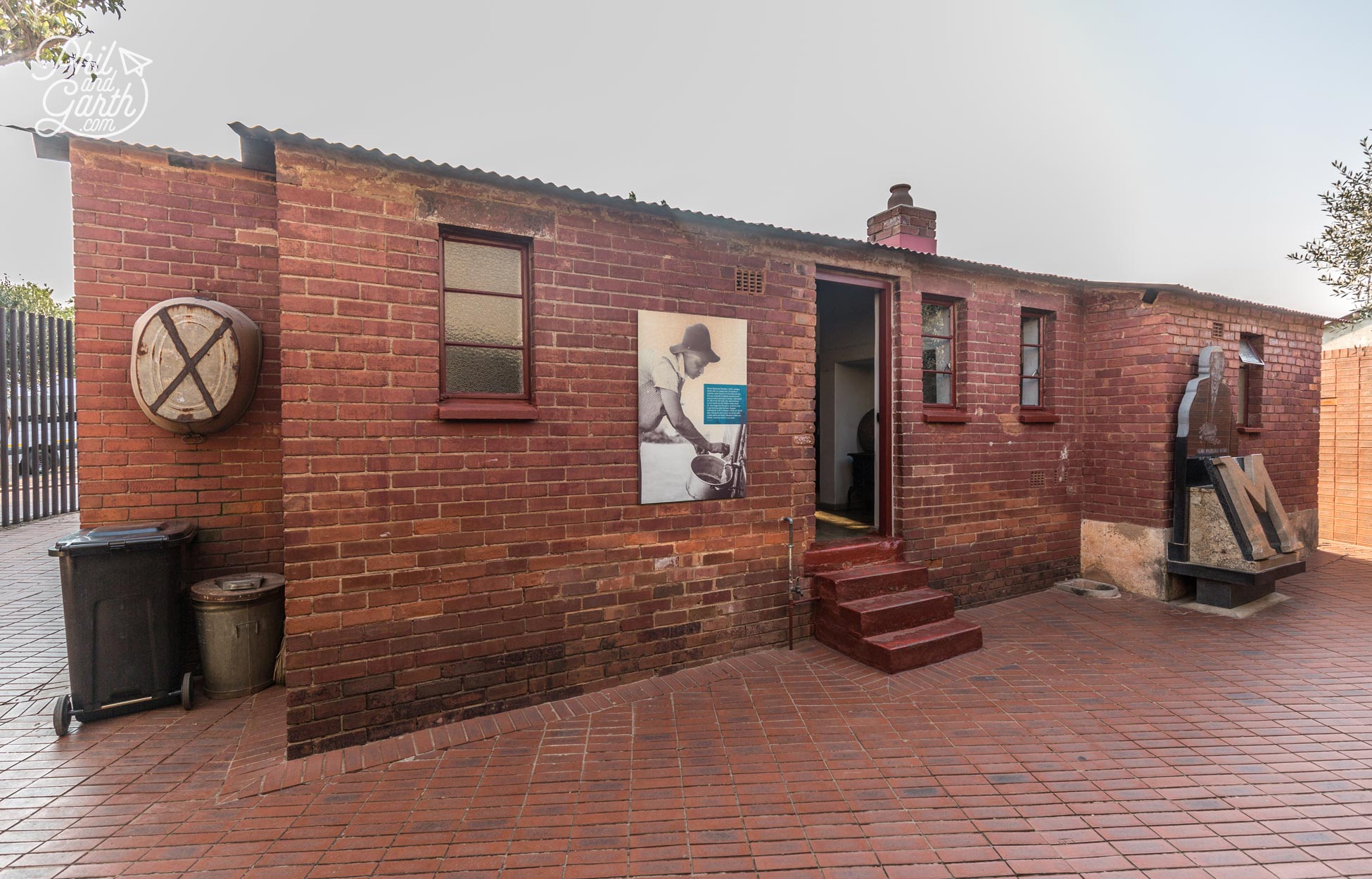
The Mandela House Museum
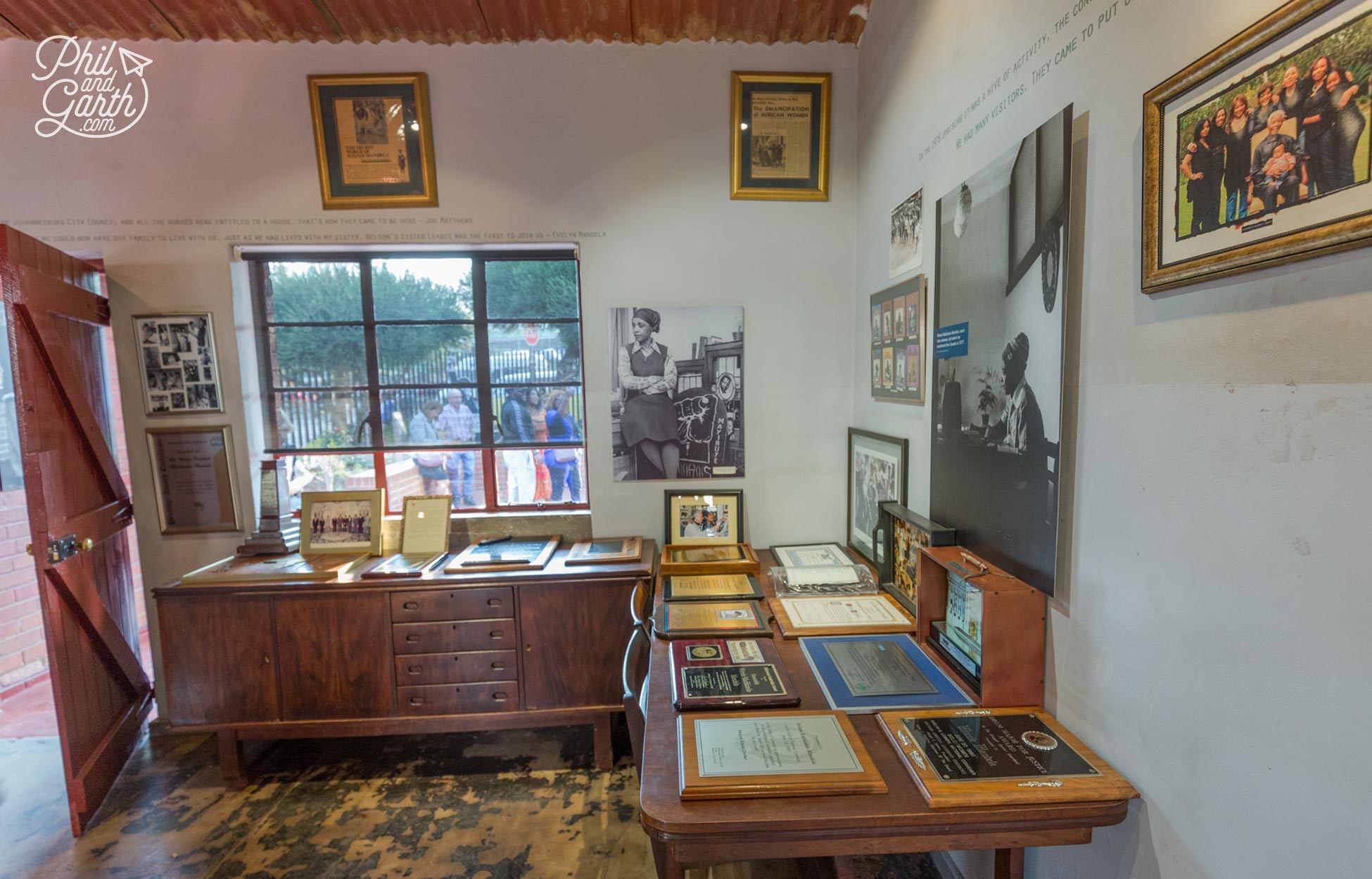
Inside Nelson Mandela’s house
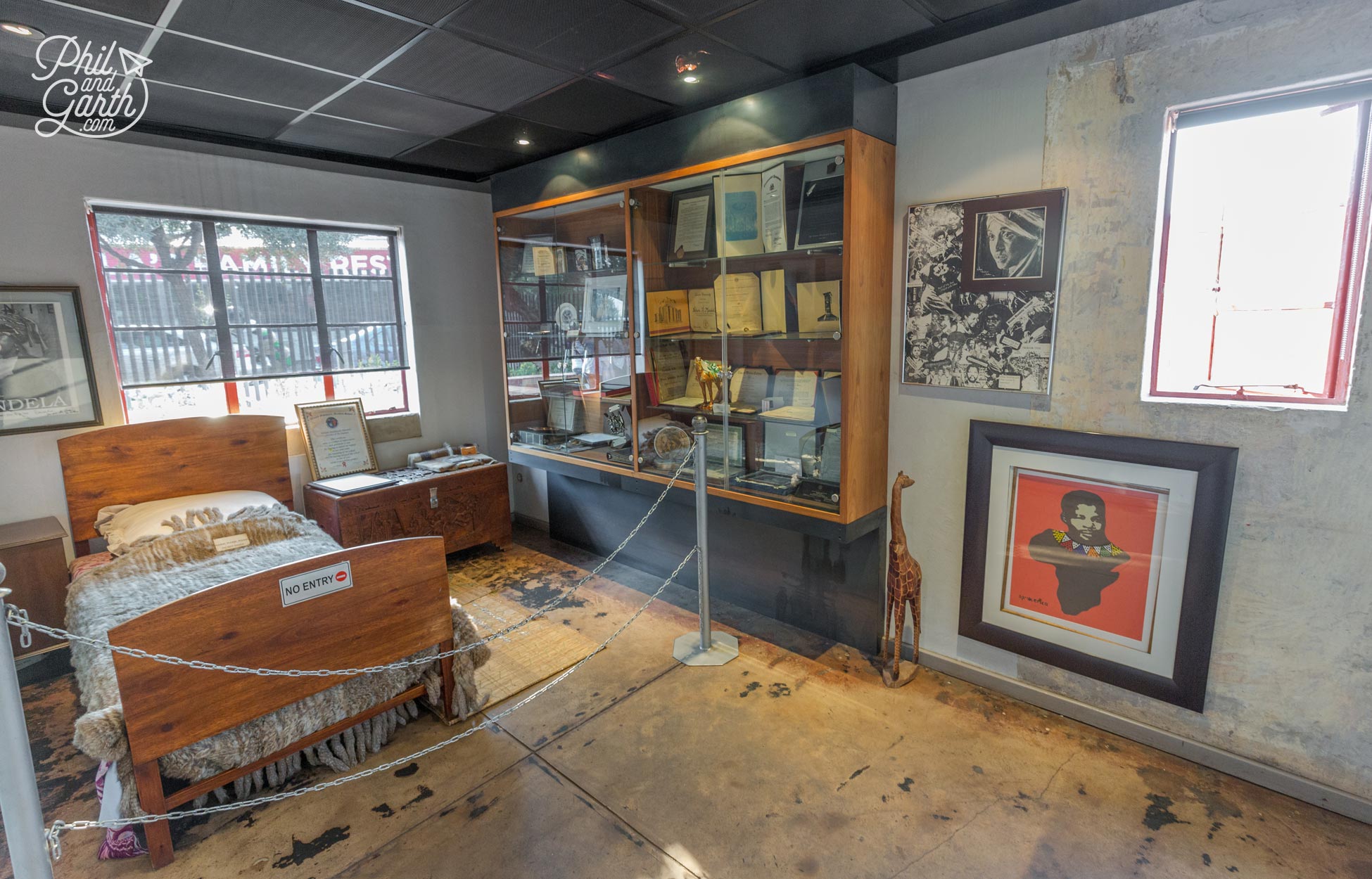
Bedroom is dressed with photographs and gifts
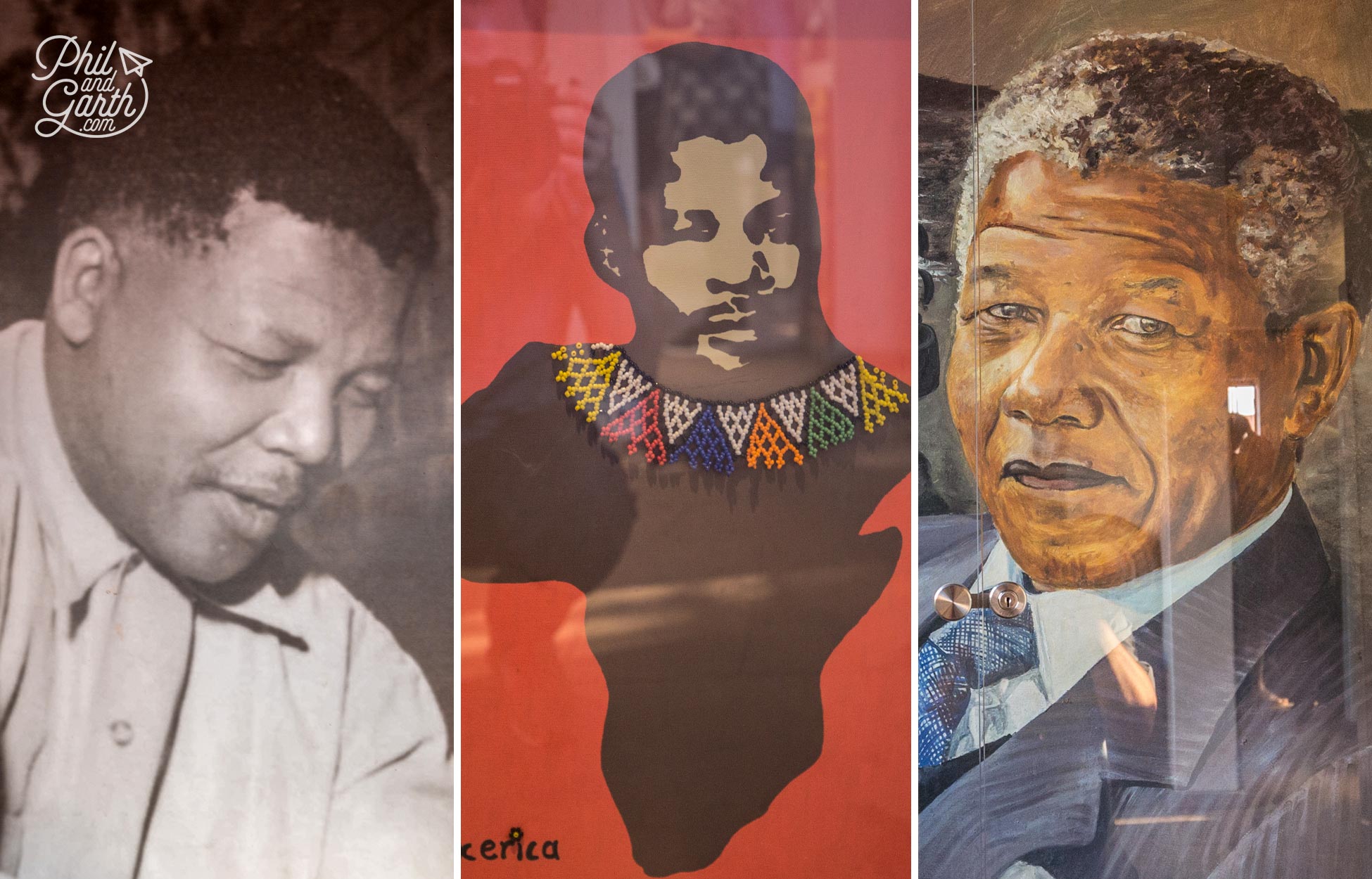
Images of Nelson Mandela in the home
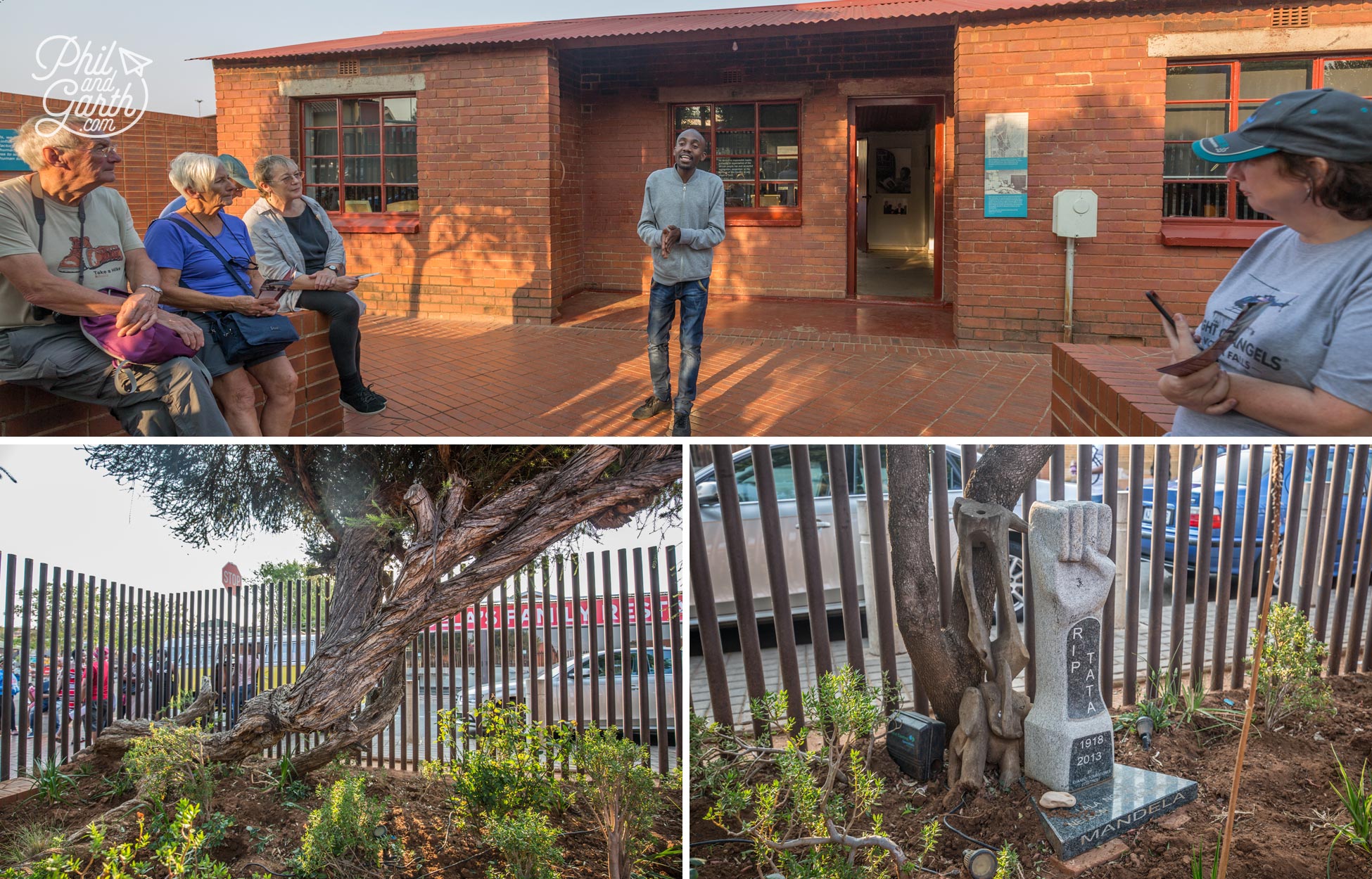
Outside in the garden of Nelson Mandela’s house
Outside in the small garden our guide told us about the fight against apartheid, it was a humbling experience listening to his stories. He also pointed out bullet holes in the red bricks near the entrance from failed assassination attempts.
The house is very busy and limits the number of visitors to go inside, just wait in turn for one of the free guided tours for the best experience. The area outside was pretty bonkers, packed with hawkers and South African students all eager to get a selfie doing ‘black power’ clenched fist pumps in the air – a symbol of defiance.
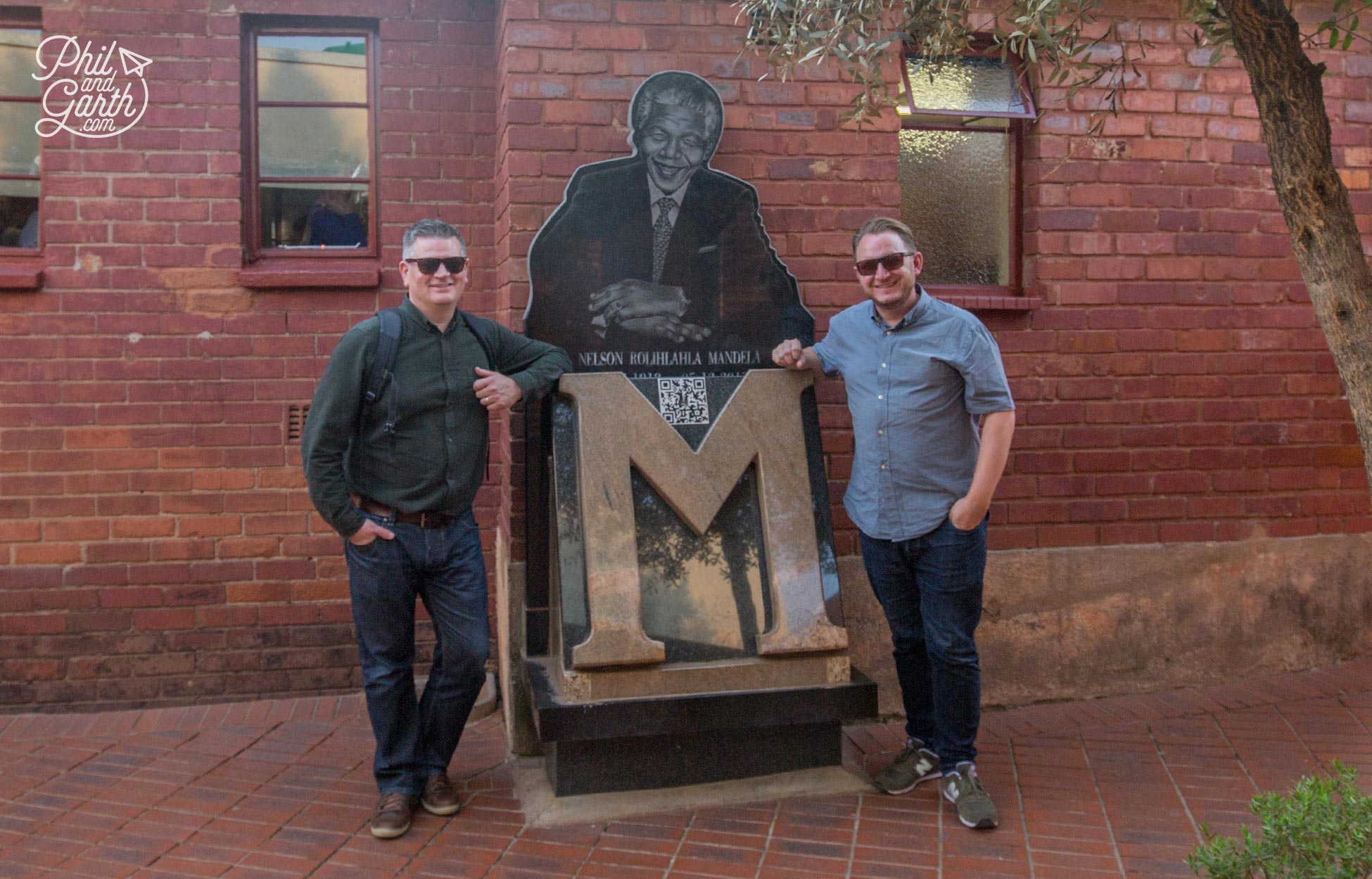
Phil and Garth with Madiba
We were both glad we got to visit Mandela’s home it’s a poignant reminder of racial discrimination and the battle for democracy. Also just a bit further down on the same street (Vilakazi Street) is the private home of Archbishop Desmond Tutu, like Mandela another Nobel Peace Prize winner.
Other Johannesburg Attractions:
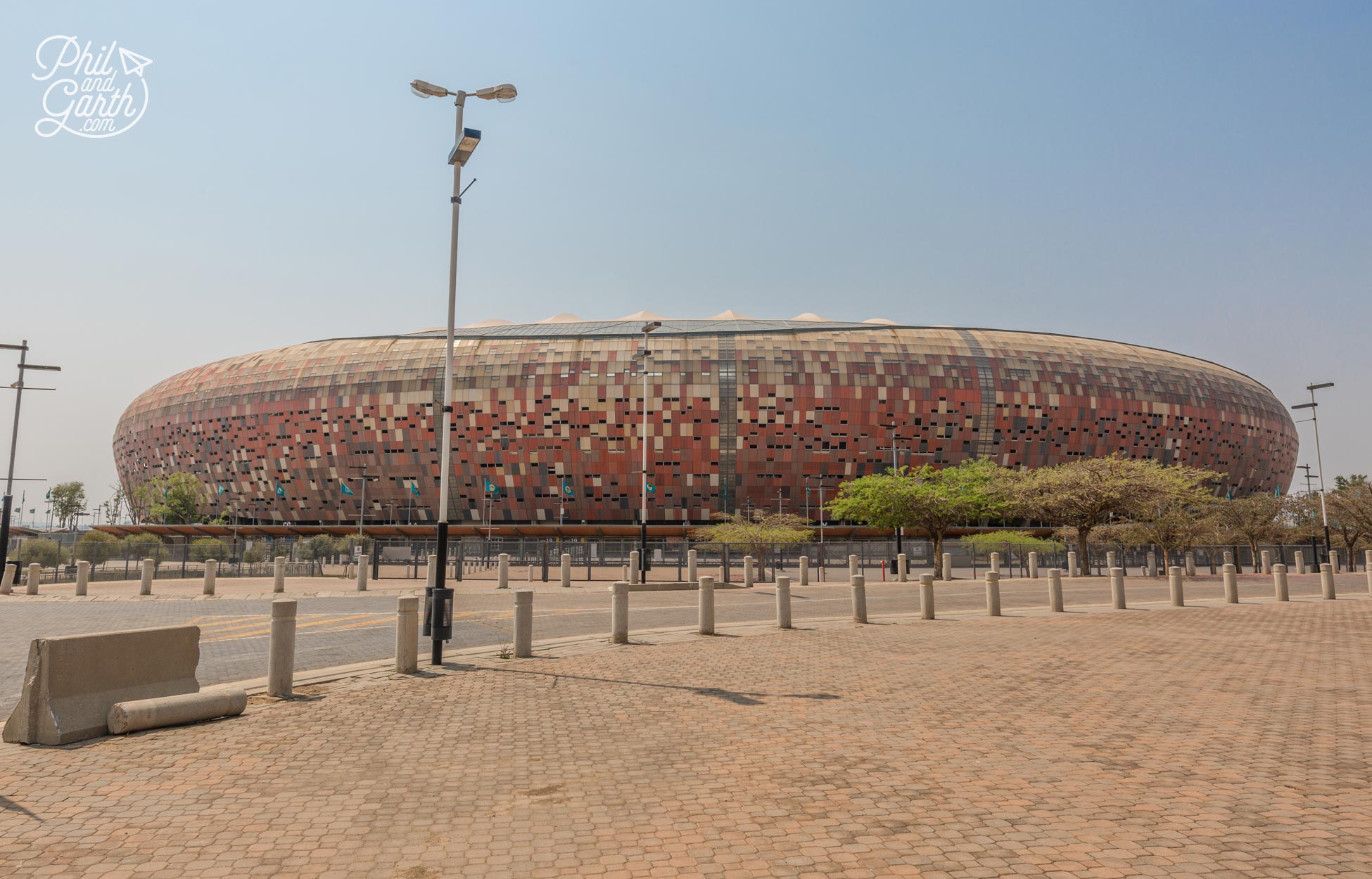
The FNB Stadium in Johannesburg
- The Apartheid Museum – Bill and Pam from our group went here independently and said it was incredible, not a happy place but an essential place to visit to learn about apartheid. We really wish we had visited too.
- Maboneng Precinct – located in downtown Johannesburg it’s fast becoming Joburg’s hipster hangout for cafes and bars.
- FNB Stadium – For footy fans, where the World Cup was held in 2010.
Supermarket Deli Delights
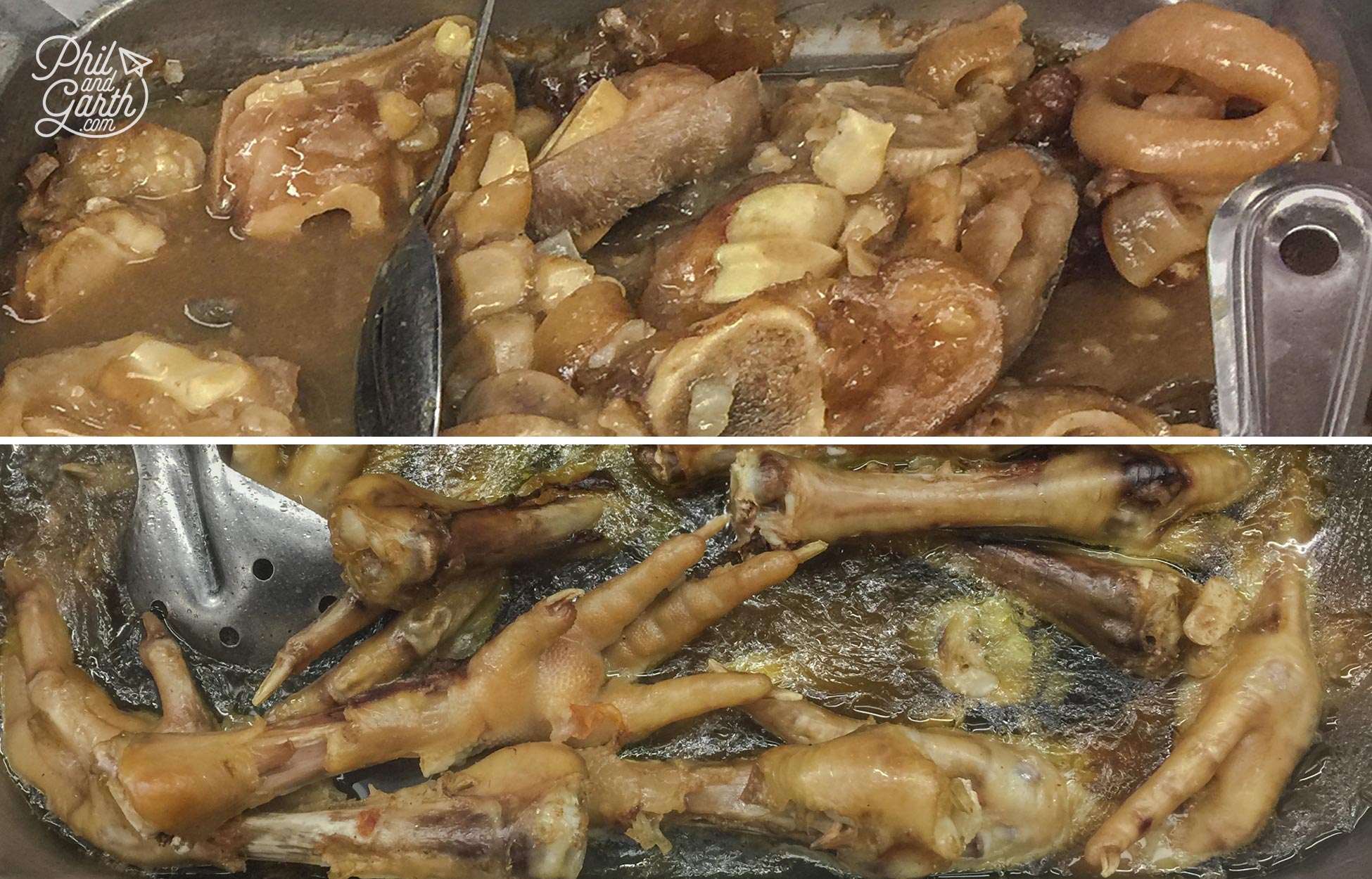
Weird Johannesburg delicacies
Finally if you’re visiting a big supermarket in Johannesburg check out the weird cooked food at the deli counter! Reminded us of the same sights we saw in China – Chicken feet or pigs bits and bobs anyone?
Johannesburg Practical Information & Useful Advice
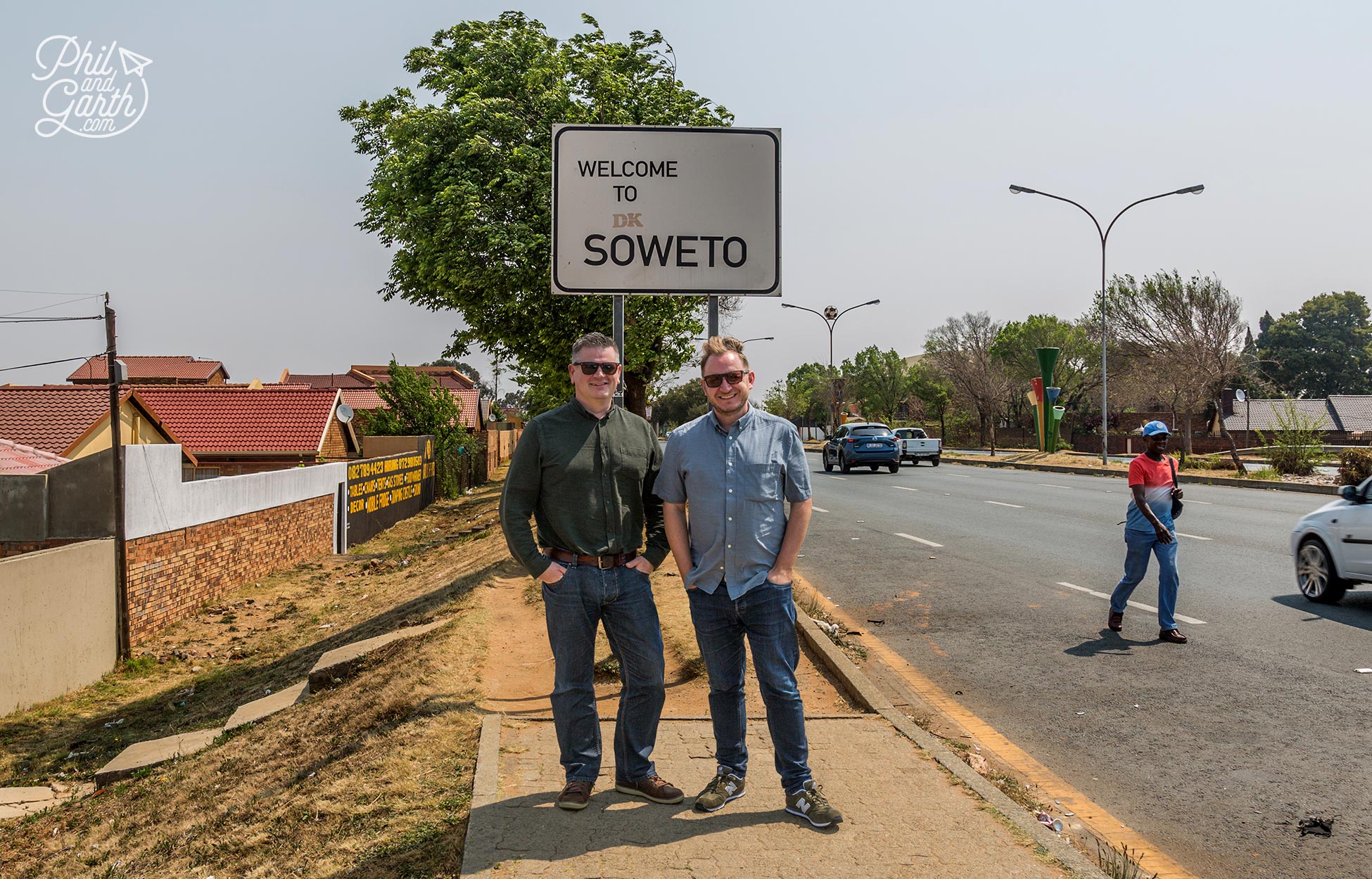
Phil and Garth in Soweto, Johannesburg
Phil and Garth’s Top 5 Johannesburg Tips
- Tip #1: Crime is an issue: Don’t be afraid, just be cautious and take guided tours or hire a guide.
- Tip #2: Tipping is not expected much like the UK, if you really want to then tip 10%.
- Tip #3: Don’t miss the Apartheid Museum like we did!
- Tip #4: Electric sockets are 3 round pins – so buy an adaptor before you go.
- Tip #5: Prices are more in high season, December – end January and July – September.
How we did it
- In Johannesburg we stayed for 2 nights at Safari Club SA – 10 minutes from the airport
- We booked and paid for an escorted small group tour of South Africa (South Africa Highlights) with Explore.






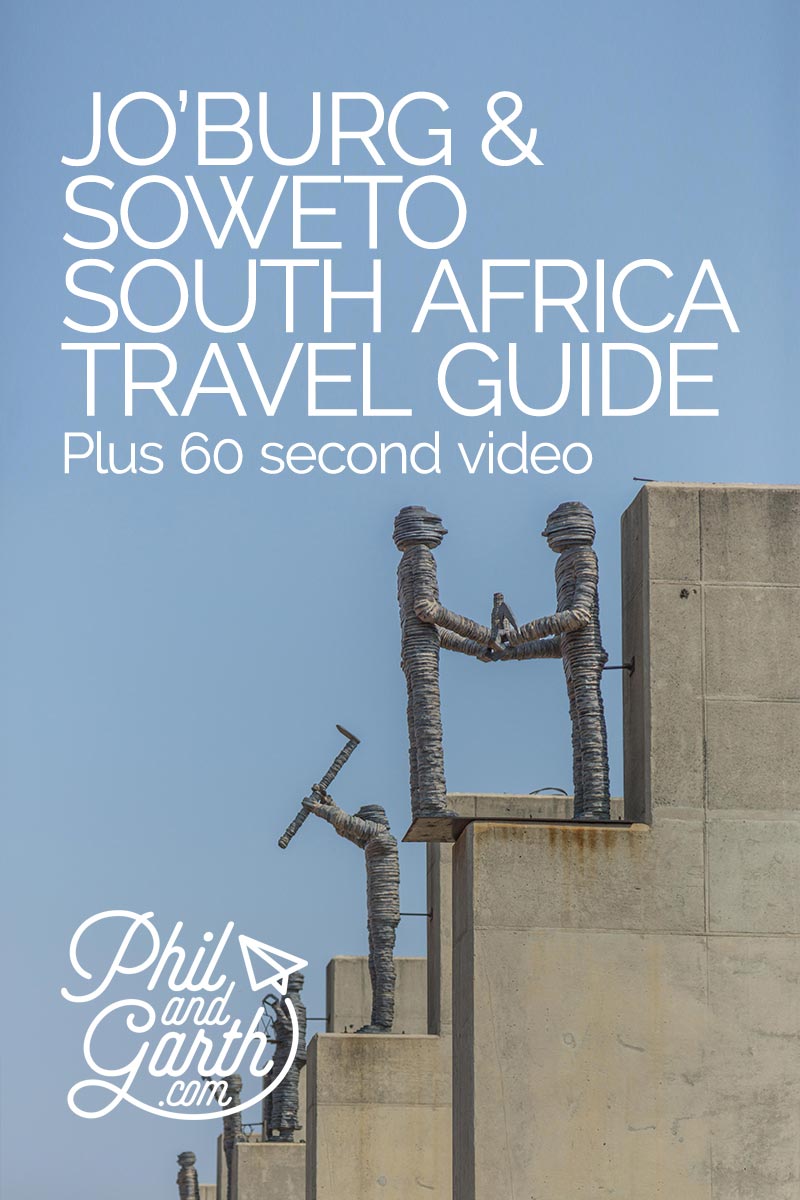
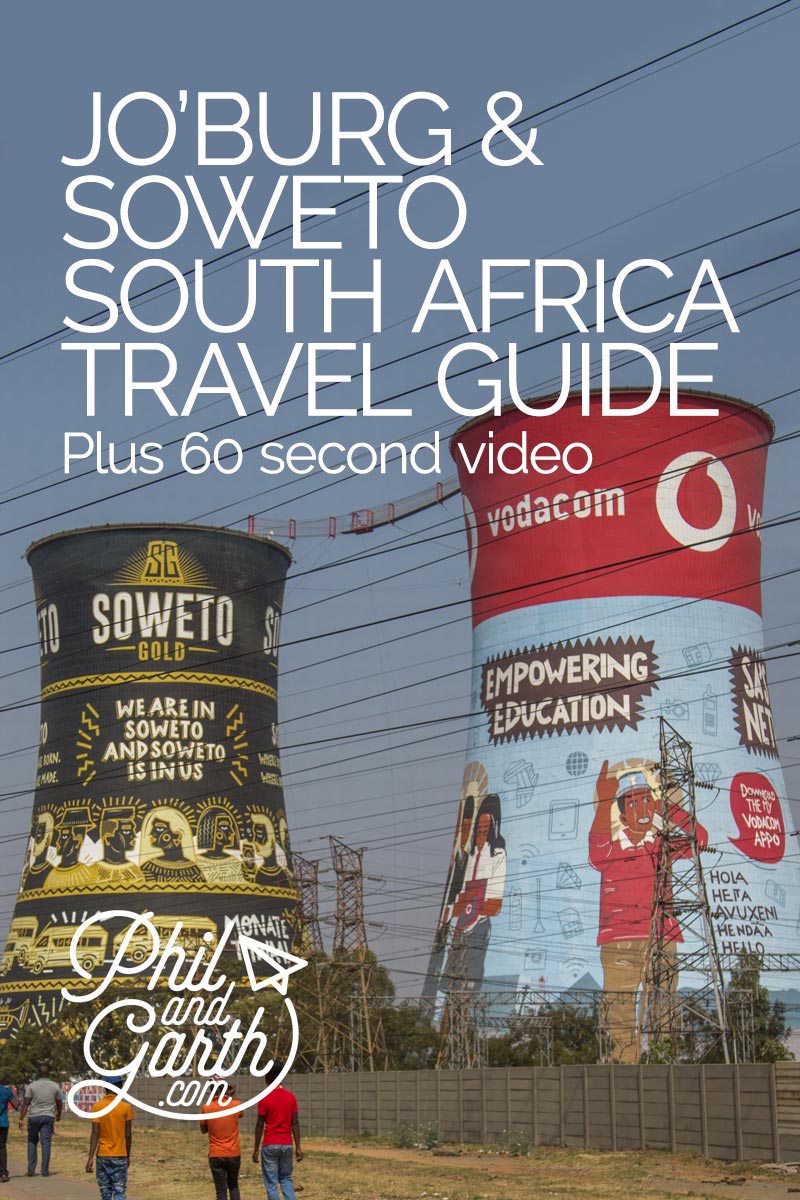
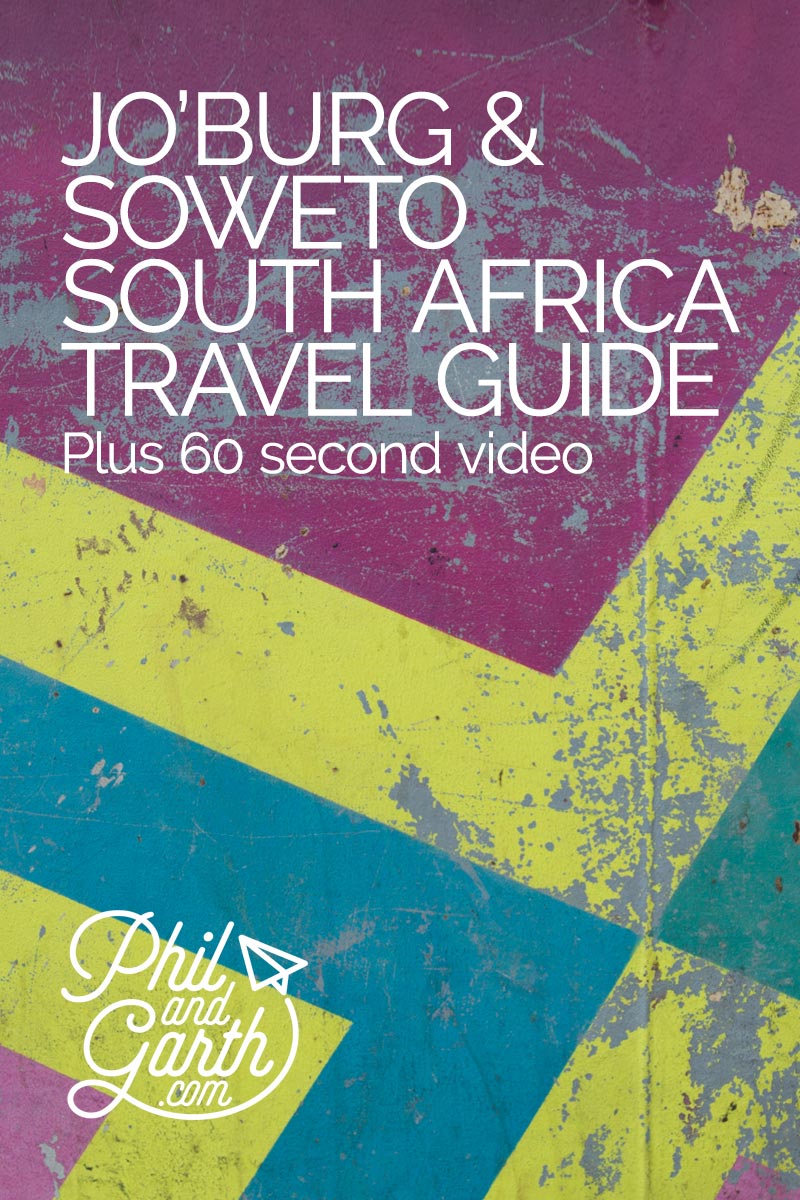
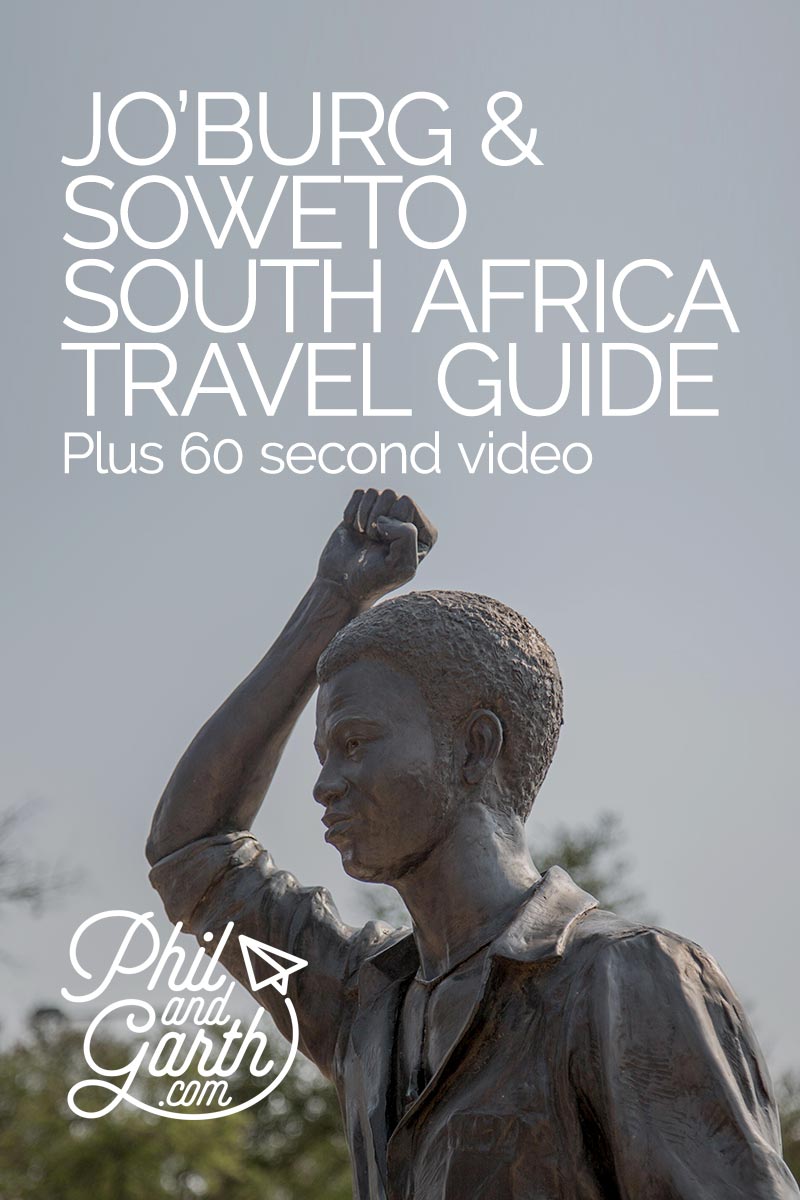
2 comments
As ever, an informative and interesting post. You managed to see a lot during the short visit.
It’s a shame you didn’t have time for the Apartheid museum, but maybe on your next visit ! Thank you for sharing your though provoking post. #feetdotravel
What a an interesting city! I think I would love to visit one day, especially so see Mandela’s house and the apartheid museums. So my history to learn! #feetdotravel